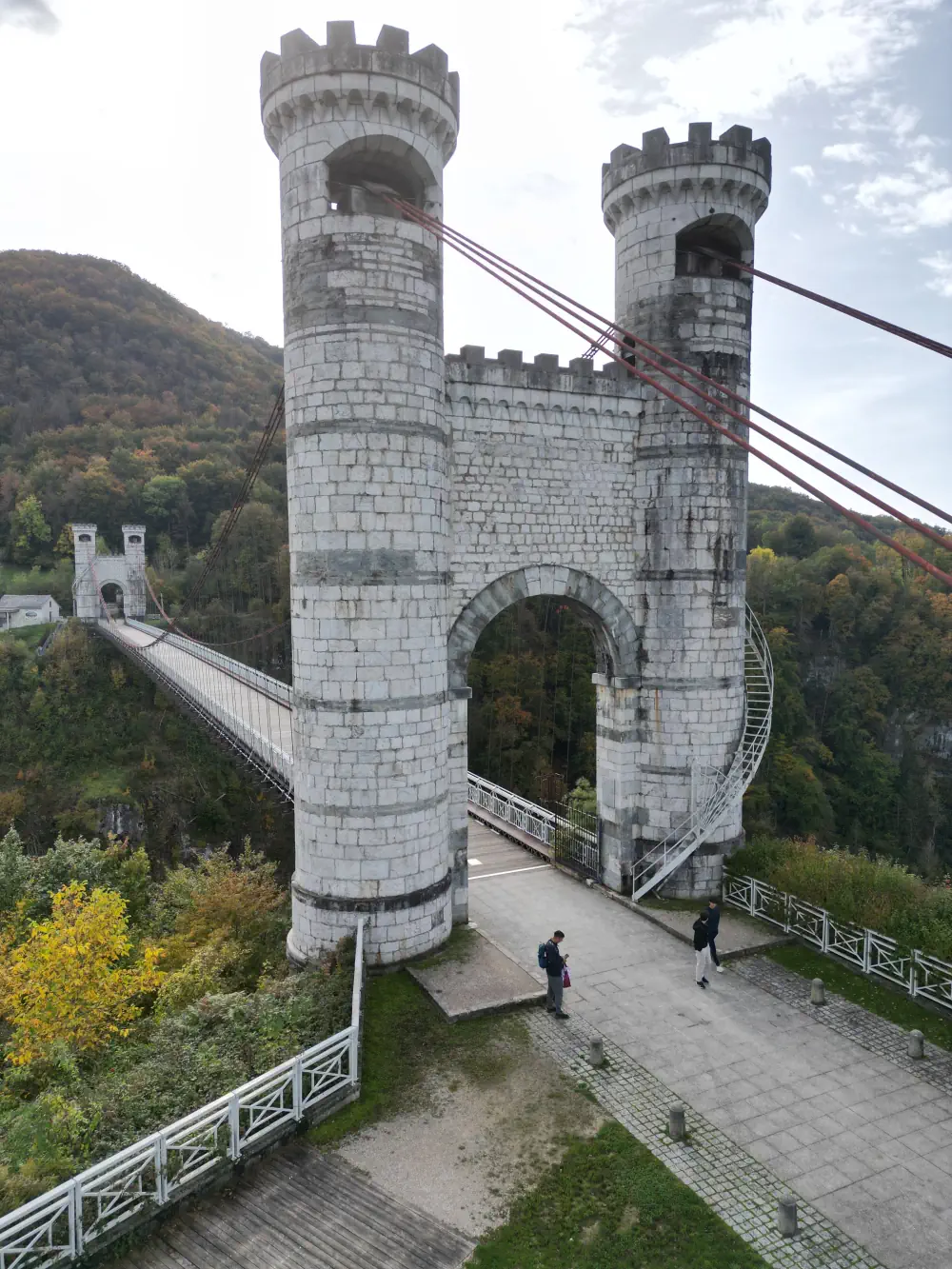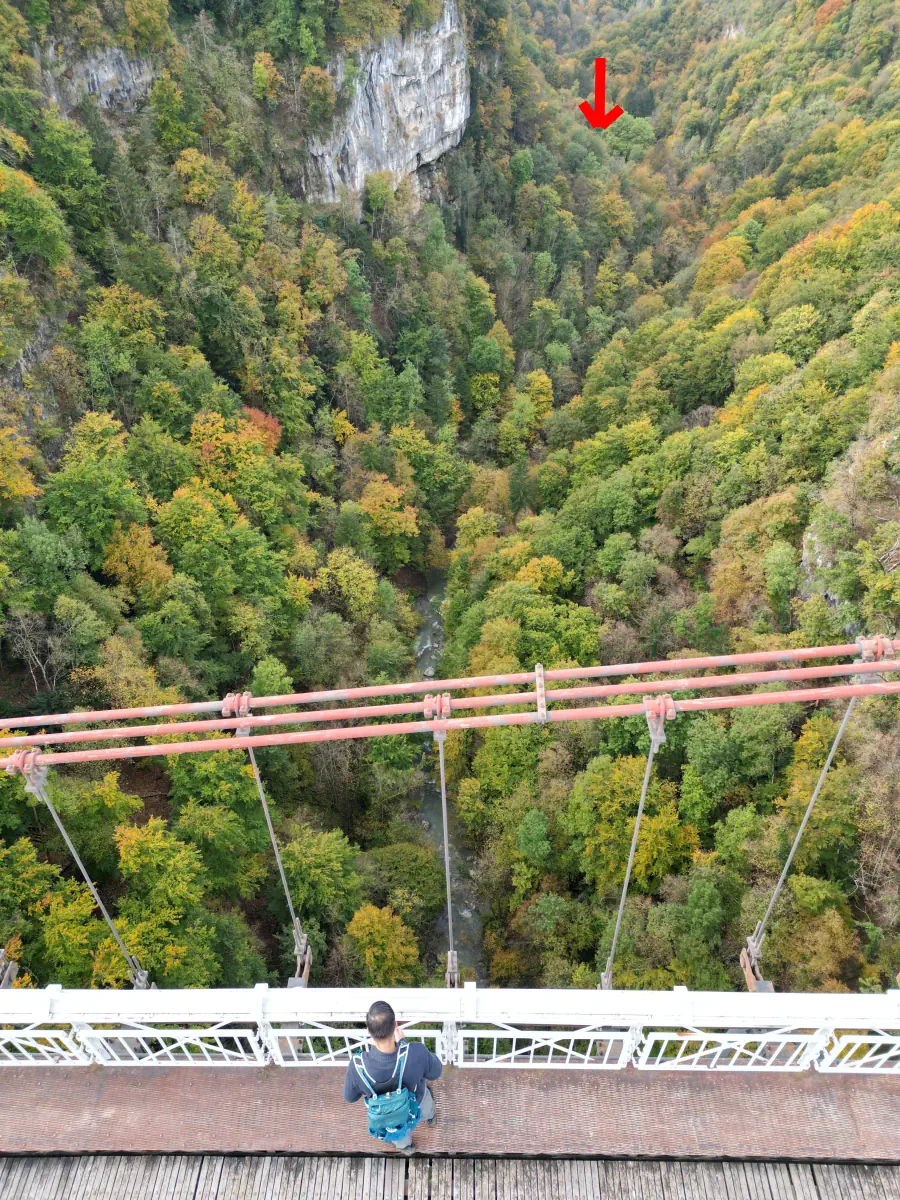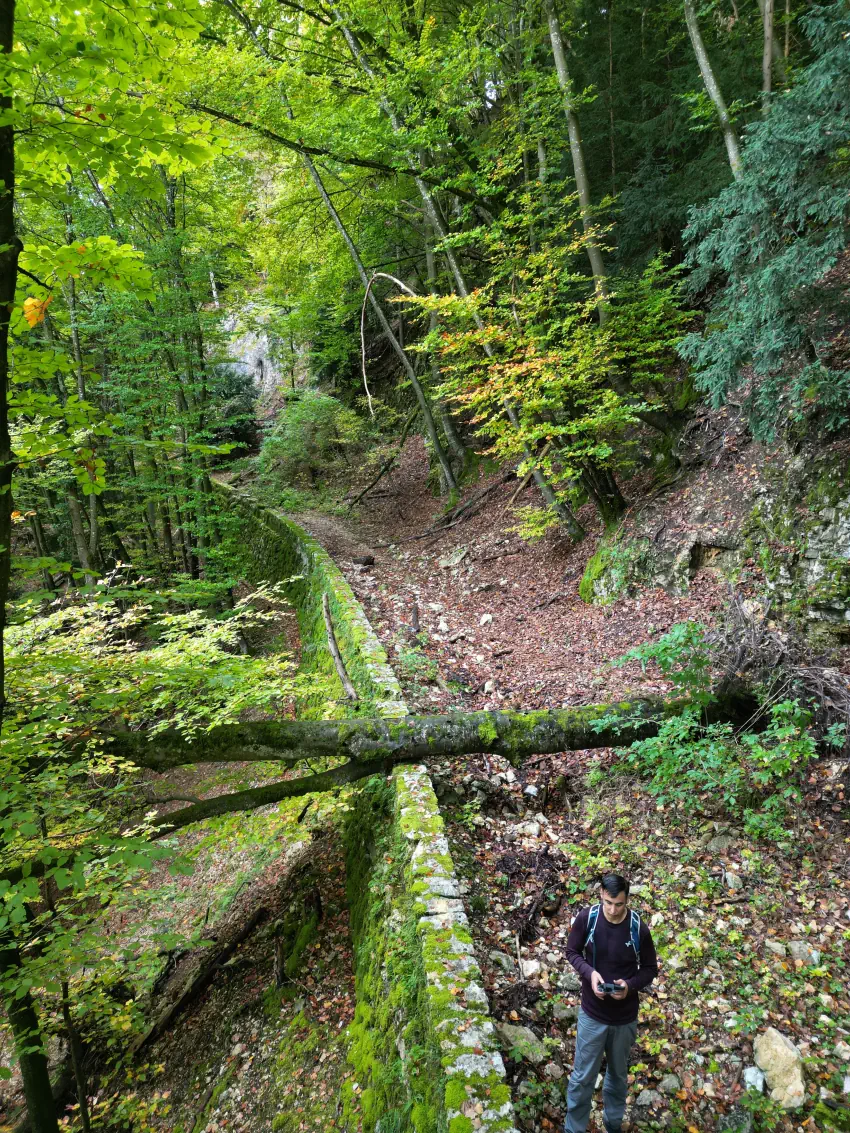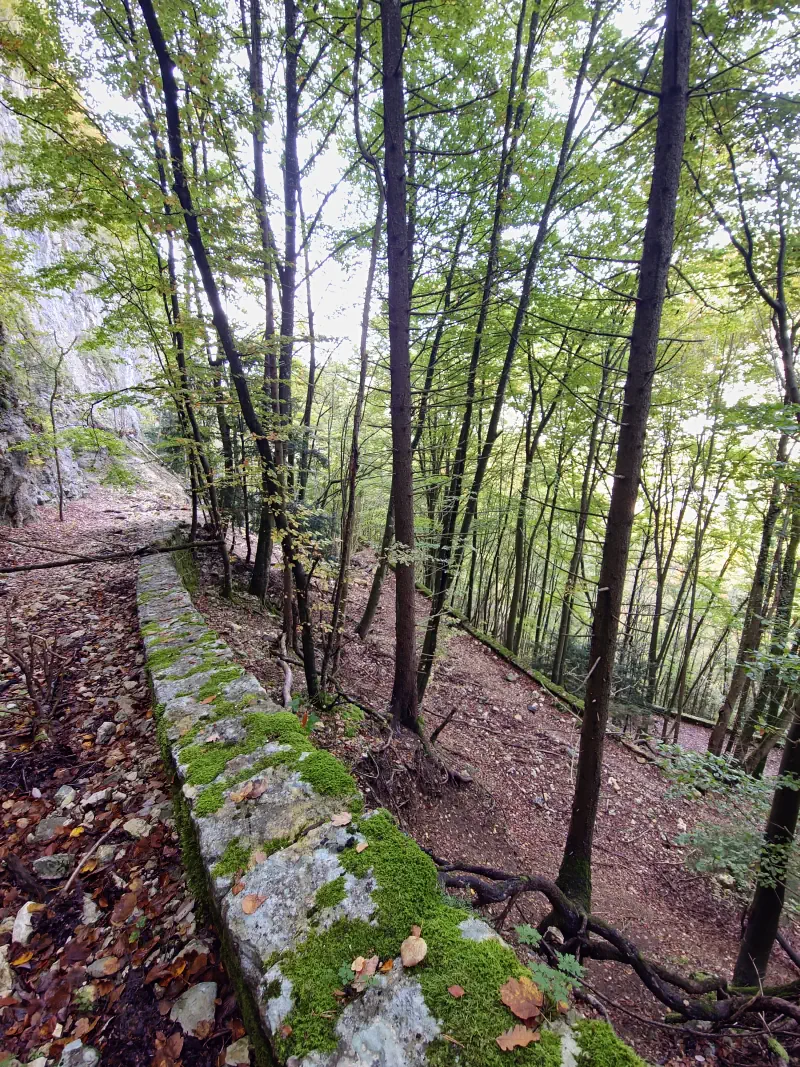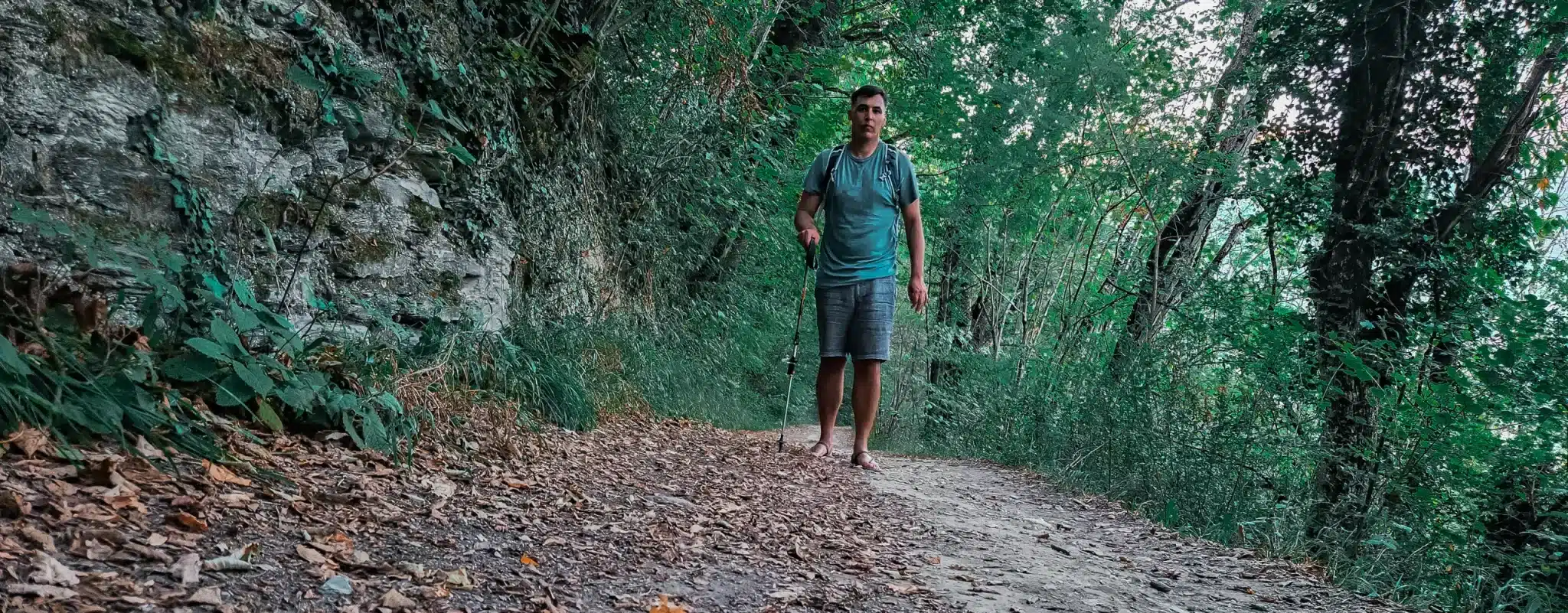Les Bains de la Caille in Haute-Savoie, France
- Nature Source Chaude
- Published on
- Updated on 11 June 2025
The ‘Fontaine de Cherpié’ is a hot spring located in the village of Alonzier-la-Caille (Haute-Savoie), near Annecy. It has long been renowned for its alkaline and sulphurous waters.
In fact, this spring has been known since time immemorial, despite being located at the bottom of a difficult-to-reach gorge. This hasn’t stopped local residents and adventurous walkers from taking advantage of its powerful healing properties. At the beginning of the 19th century, when thermal baths and mineral waters were becoming increasingly popular, the spring attracted the attention of entrepreneurs.
Table of Contents
From the Pont de la Caille to the Old Baths
The Charles-Albert Bridge, also known as the Pont de la Caille, is a landmark of Haute-Savoie. Reaching a height of 147 metres, it spans the Usses torrent over a distance of 192 metres.
Built in 1839, it is a designated historic monument. It is considered to be the world’s oldest cable-stayed suspension bridge. This unusual bridge has raised the profile of the region’s thermal baths, attracting attention in the local press as far afield as Geneva.
The first impression is one of profound emotion. This impressive structure is magnificent in its own right, and the deeply incised valley it overlooks is equally stunning.
From Cruseilles, I crossed the bridge and enjoyed the magnificent view, with a rock face to my left. A path called the ‘chemin des Bains‘ leads from above these rocks down to the Usses Gorge and on to the baths.
This path is wide, tree-lined and sometimes very stony. In some places, large rockfalls from nearby rock faces disturb the path.
The path leading to the baths is lined by a desolate forest, littered with uprooted and broken trees, and strewn with rock debris.
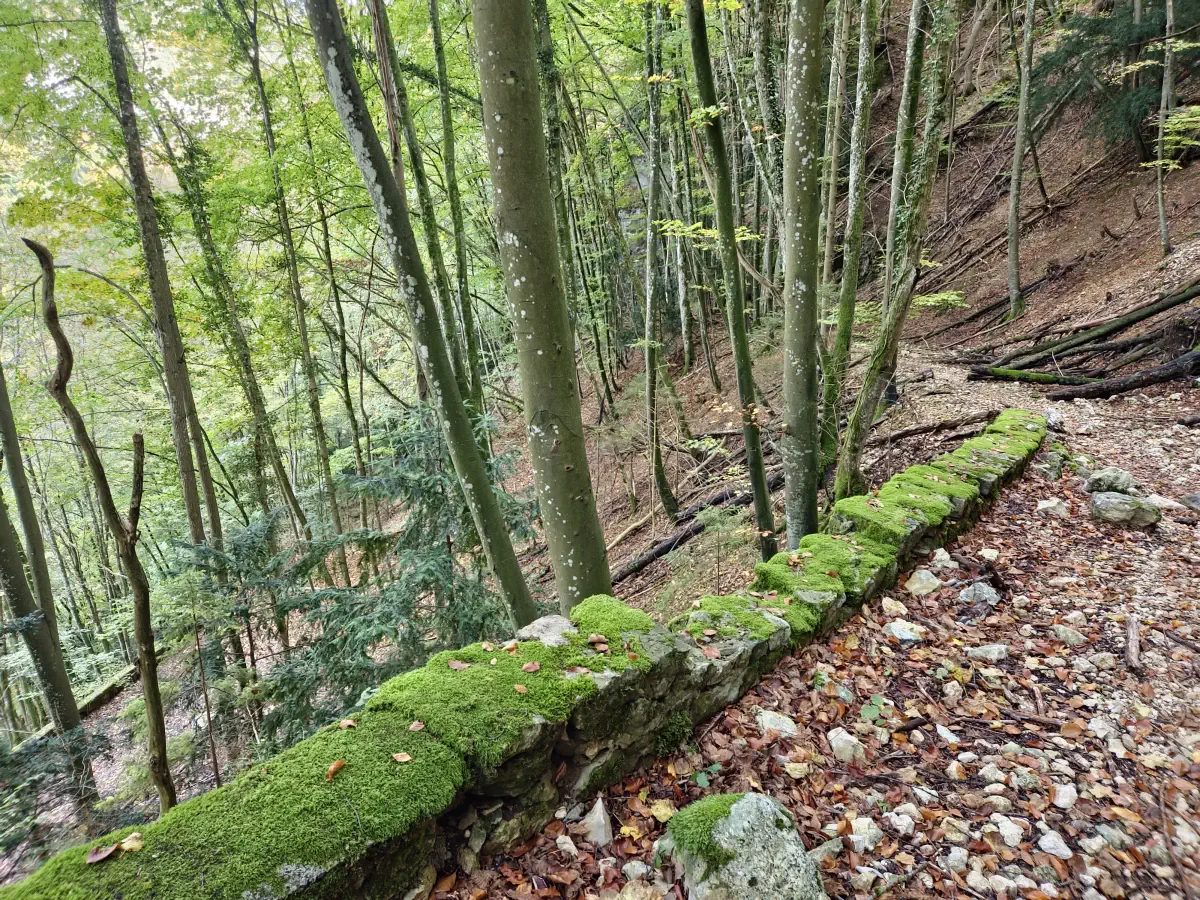
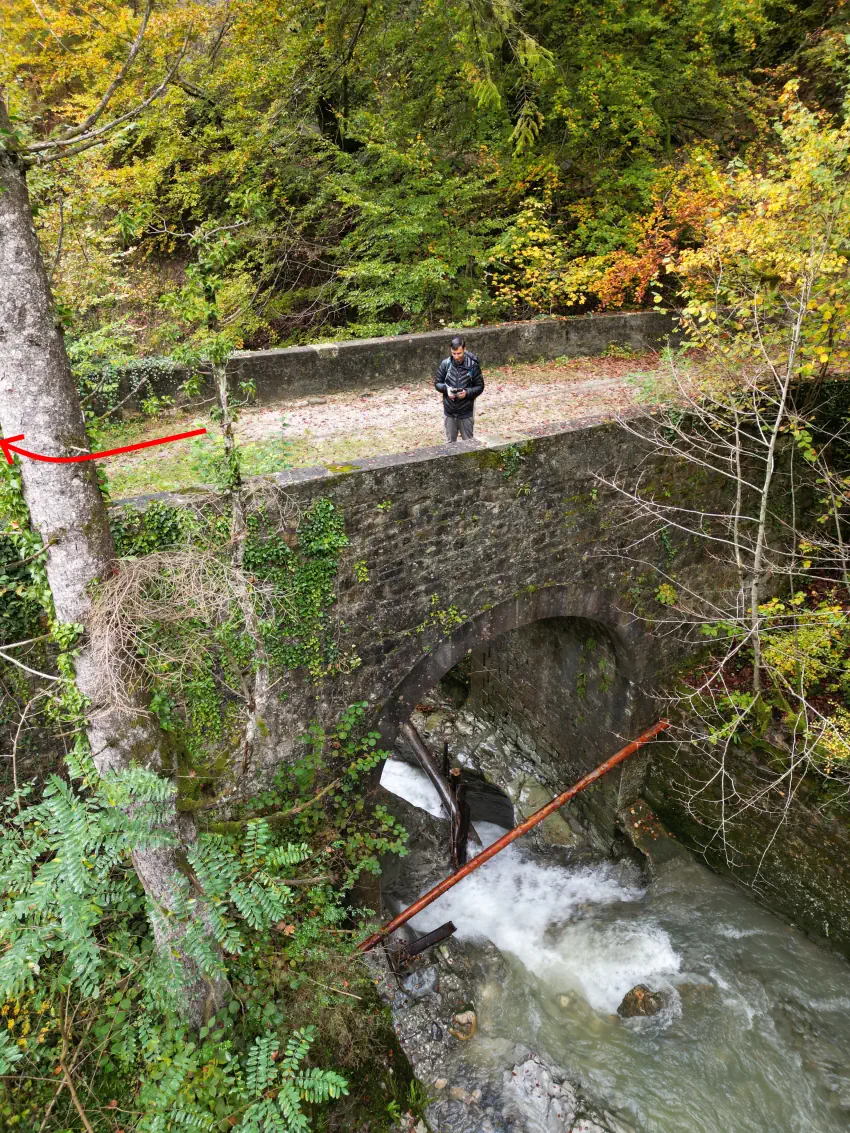
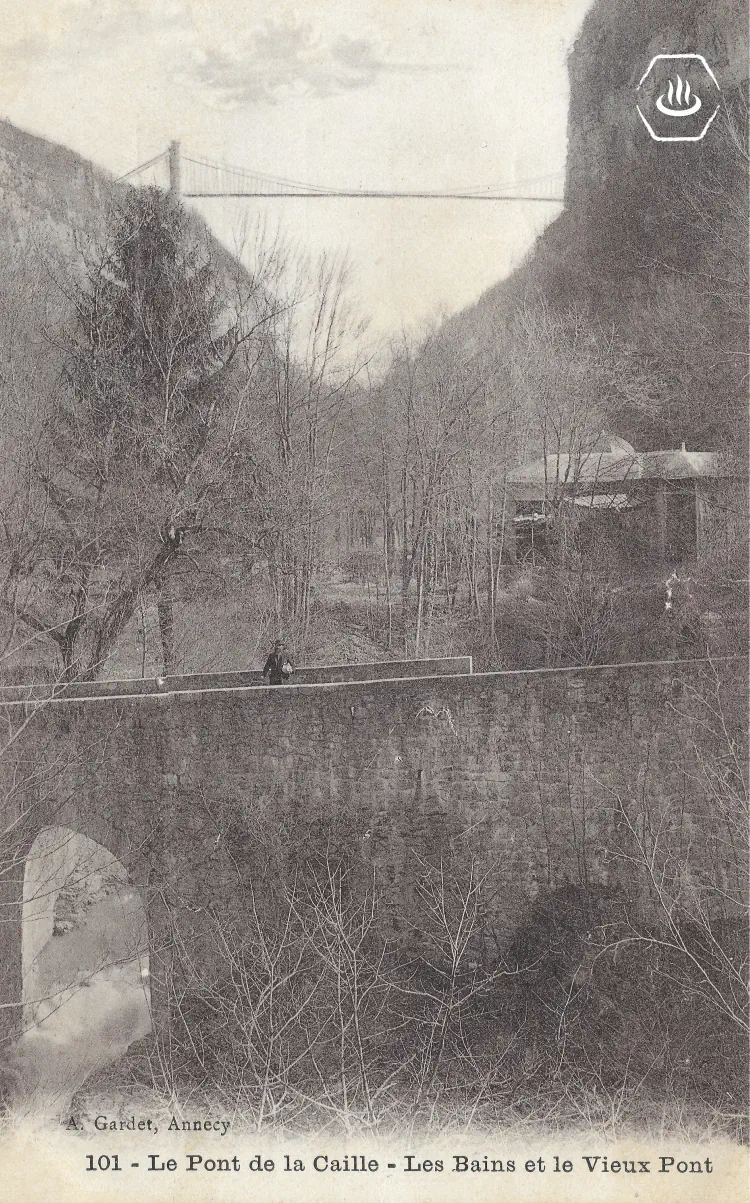
To reach the gorge, walk downhill following the zigzags until you reach a stone bridge. The old baths are on your right.
The birth of a spa station
There has long been a hot (30°C), alkaline, sulphurous spring in the deep gorge on the left bank of the Usses torrent. These waters have been well known and used by people for millennia. However, they only came back into fashion in the 19th century, having been forgotten for many years.
In 1825, Michel Baussand, a Copponex resident, built wooden huts on one of the spring’s two griffons with the help of a few neighbours and Annecy residents. This enabled them to accommodate the increasing number of bathers each year.
The first narrow, light masonry structure was built on the Cruseilles hillside in 1827 and remained in use for 20 years.
In 1838, Jean-François Burdallet left us with two depictions of the Bains de la Caille (see the images below). The first shows the barracks, with the start of the right abutment of the new bridge visible at the top left. The second lithograph shows a view from the right abutment of the new bridge. From this vantage point, the Usses torrent and the spa can be seen further ahead.
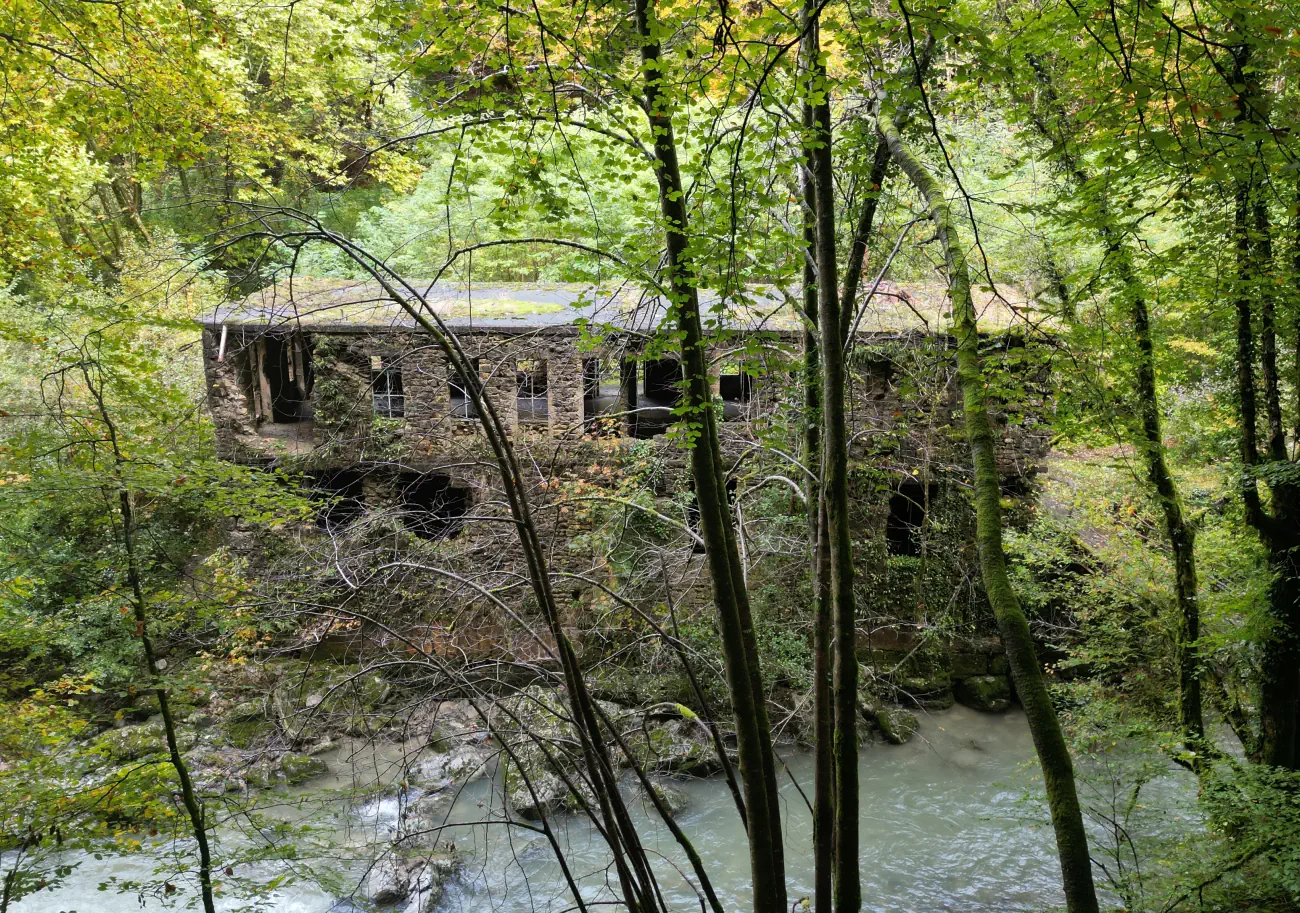
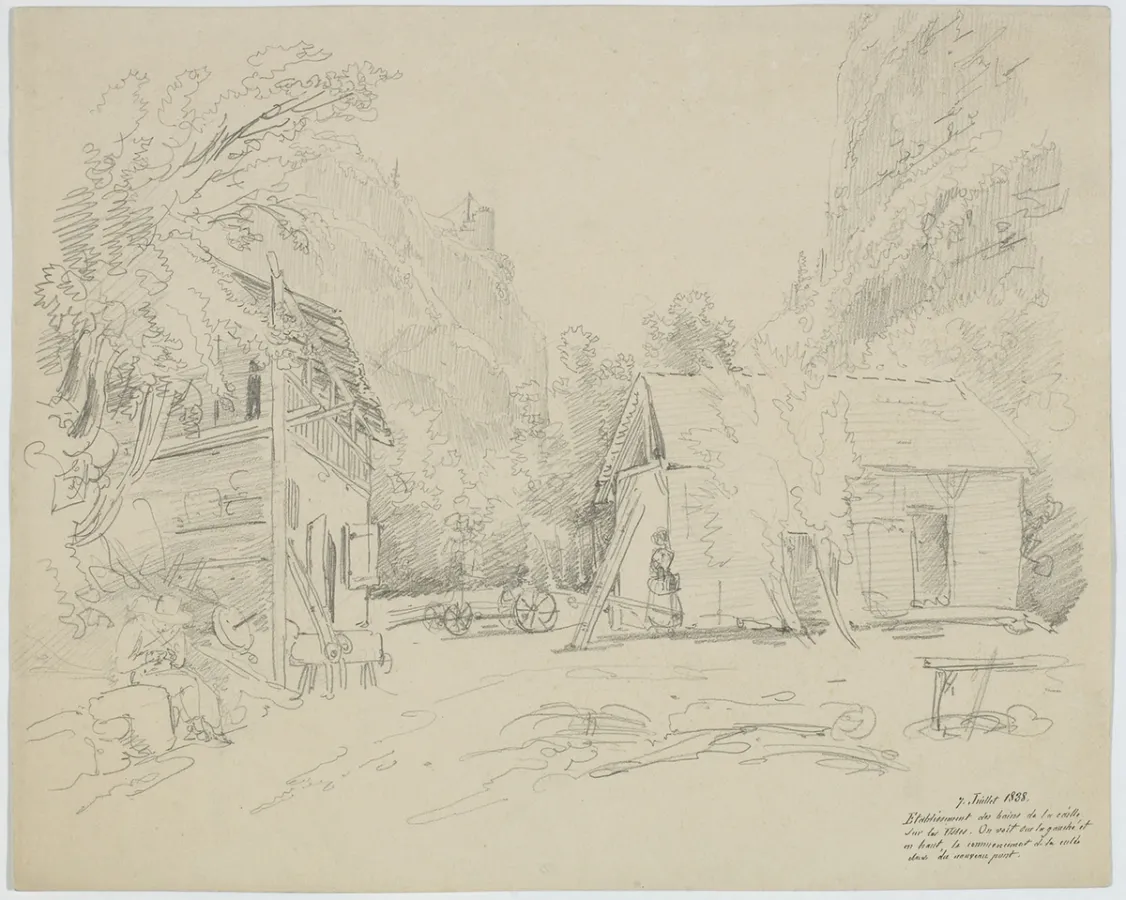
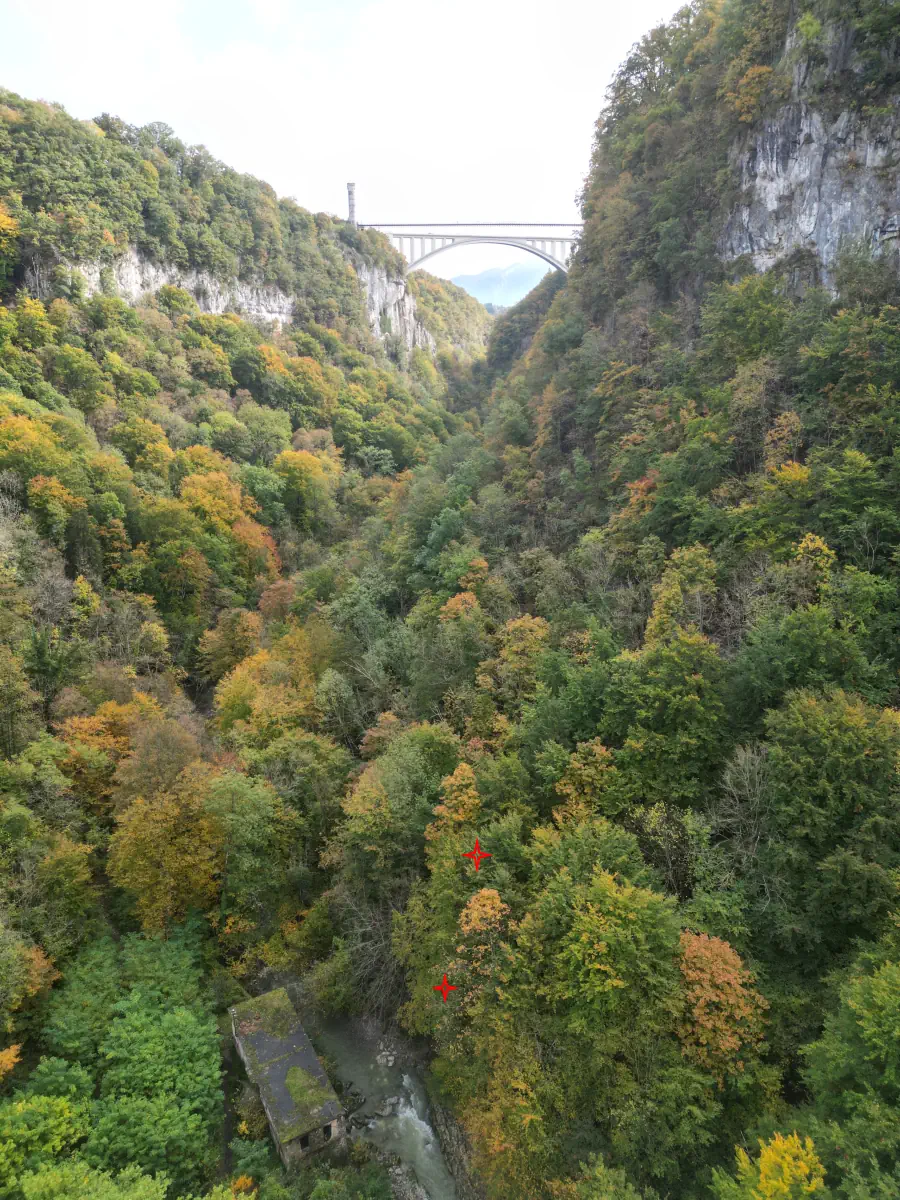
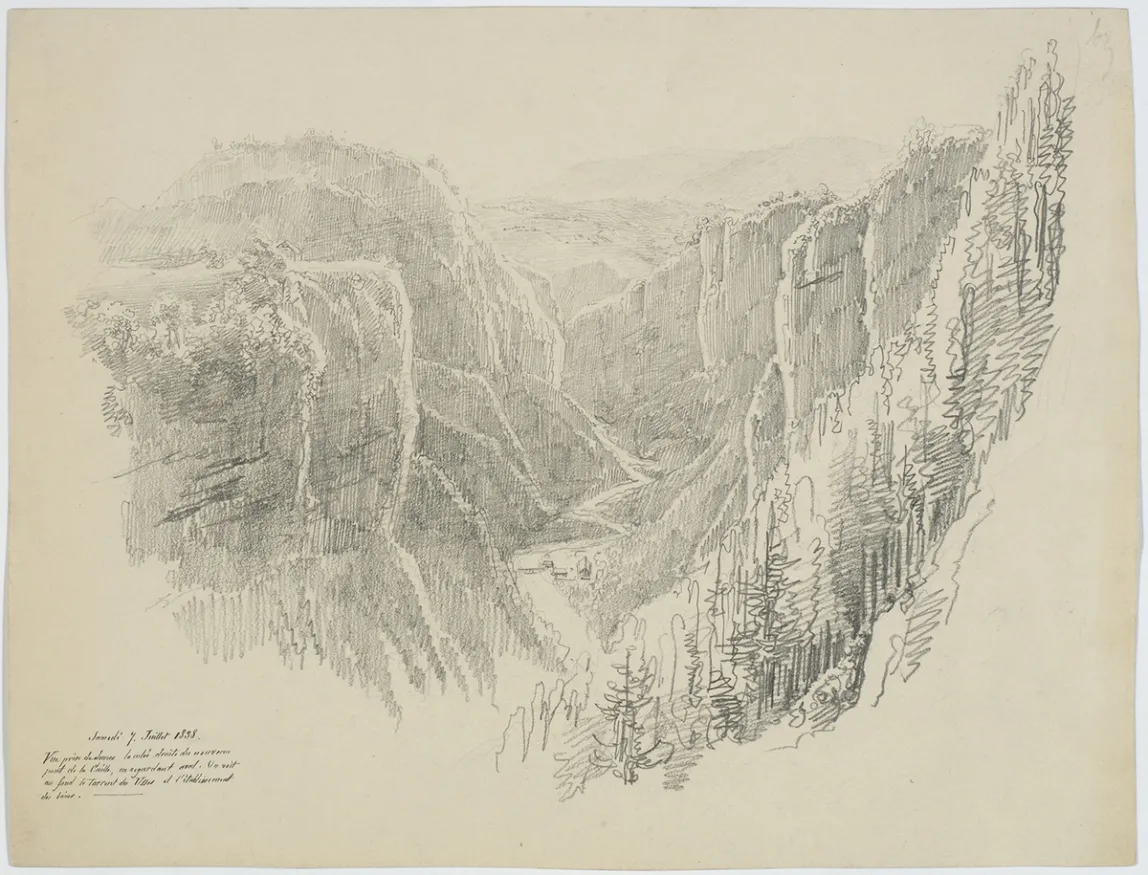
The ruins of the Roman baths were discovered during clearance works near the springs in 1847. That same year, Canon Crozet-Mouchet became the owner of the land and springs.
Following numerous studies, work on several buildings began in 1848. Crozet-Mouchet secured the construction of a winding carriage road leading down from the magnificent 147-metre-high Charles-Albert Bridge to the spa station. This replaced a dangerous path suspended over the valley, which could only be accessed by fit individuals.
The site was inaugurated in 1852 in front of all the local authorities in Annecy, as well as over 1,000 spectators from the region and beyond — including from Geneva and Lausanne in Switzerland.
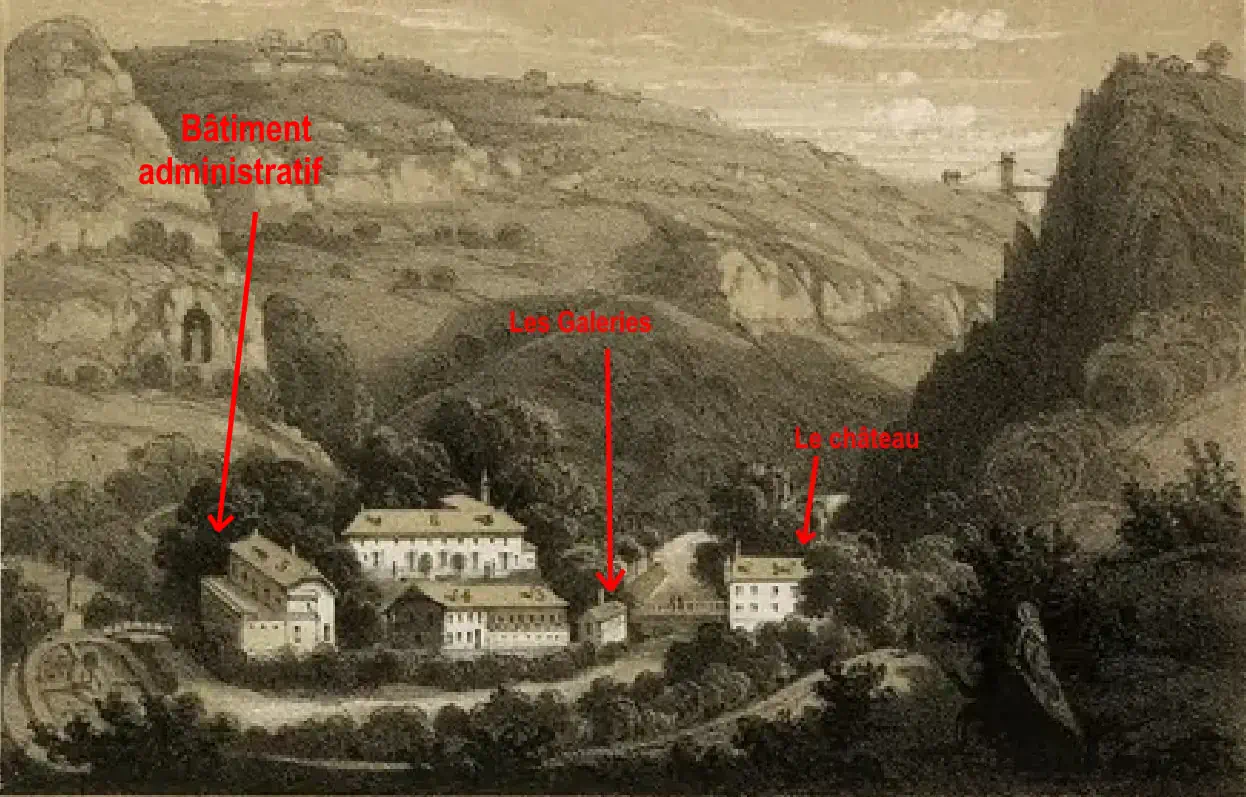
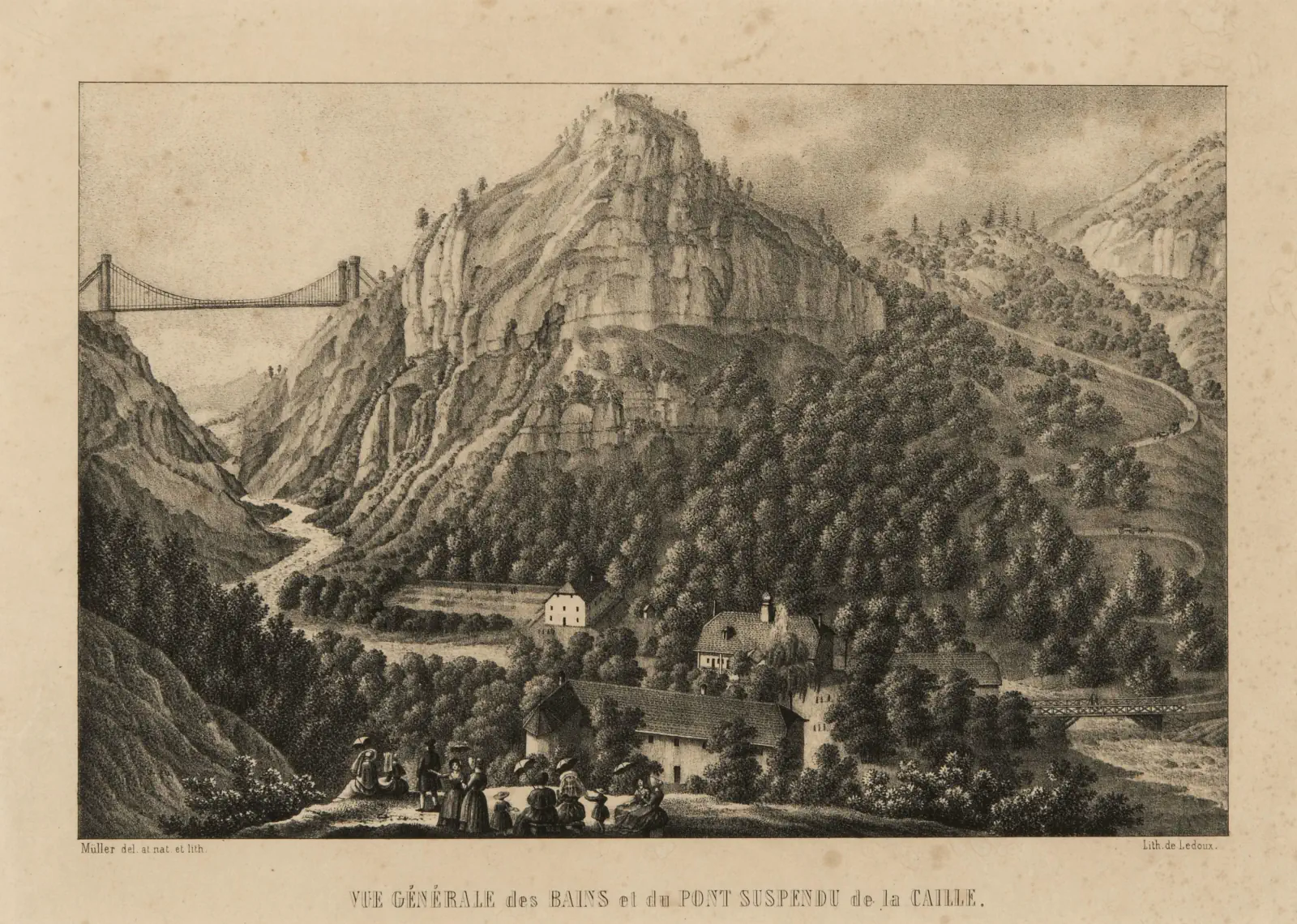
The two images above depict a society organised around several immaculately appointed buildings. These include a chapel, stables, kitchens, dining rooms with capacity for up to 150 guests, bathrooms, showers, reservoirs, bedrooms for travellers, dormitories for servants, lounges, games rooms and doctors’ surgeries. Over time, the buildings were extended and modernised wherever possible.
In terms of spa facilities, the first building on the right after crossing the footbridge is known as the ‘Château‘ or ‘Castle’ (see the marked location on the image below). This building contains the most sulphurous spring. The ground floor has twelve bathing cubicles, while the first floor has eight bedrooms. This unique establishment enables people with pulmonary tuberculosis to inhale sulphurous gas (hydrogen sulphide) while they sleep.
A second spa building, known as ‘Les Galeries‘, originally contained fifteen bathing cubicles on the ground floor, a covered gallery on the first floor, and servants’ dormitories on the second floor (see the marked location in the image below). The building is now in a state of disrepair, but it is the only remaining structure on the site.
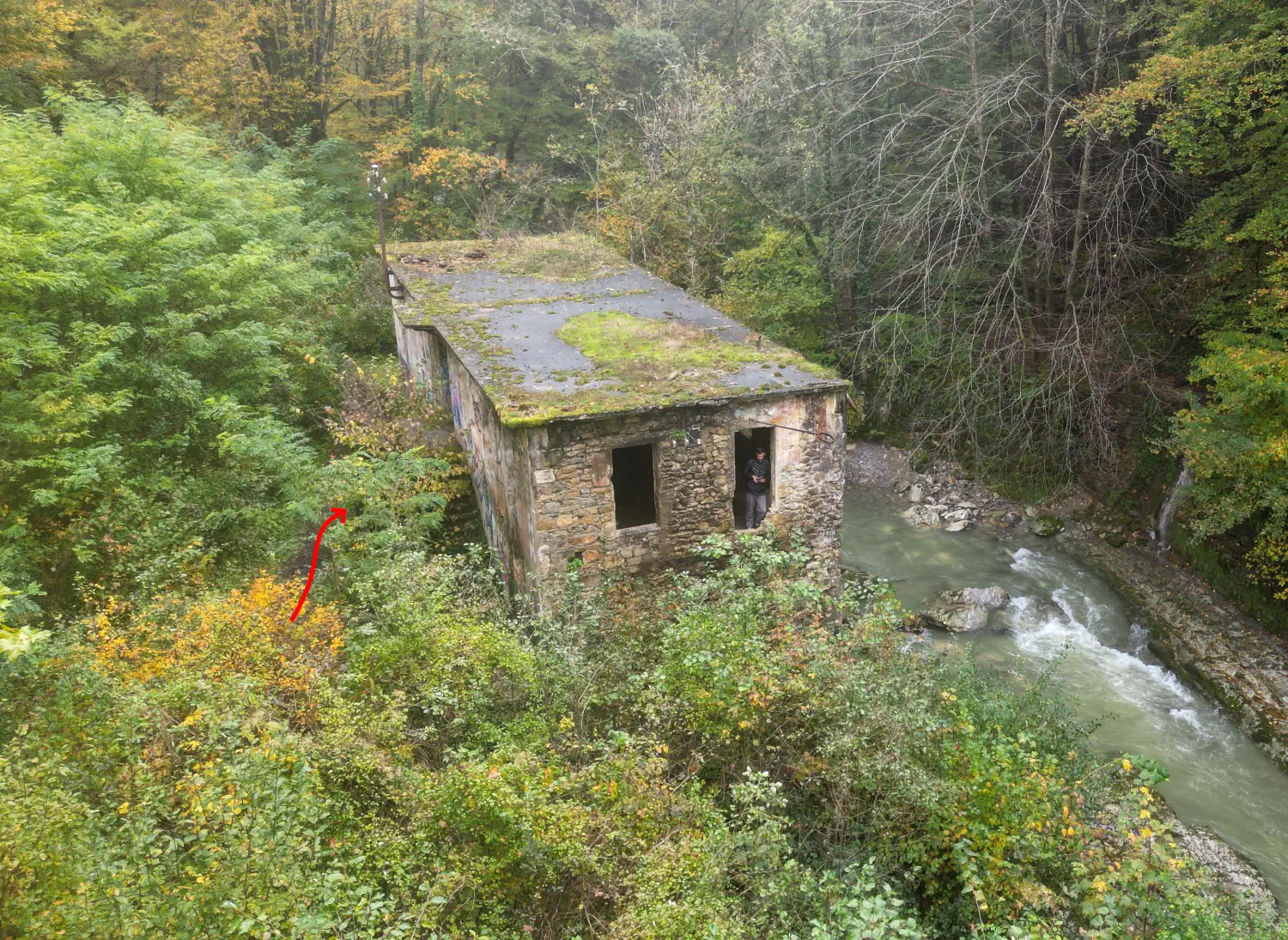
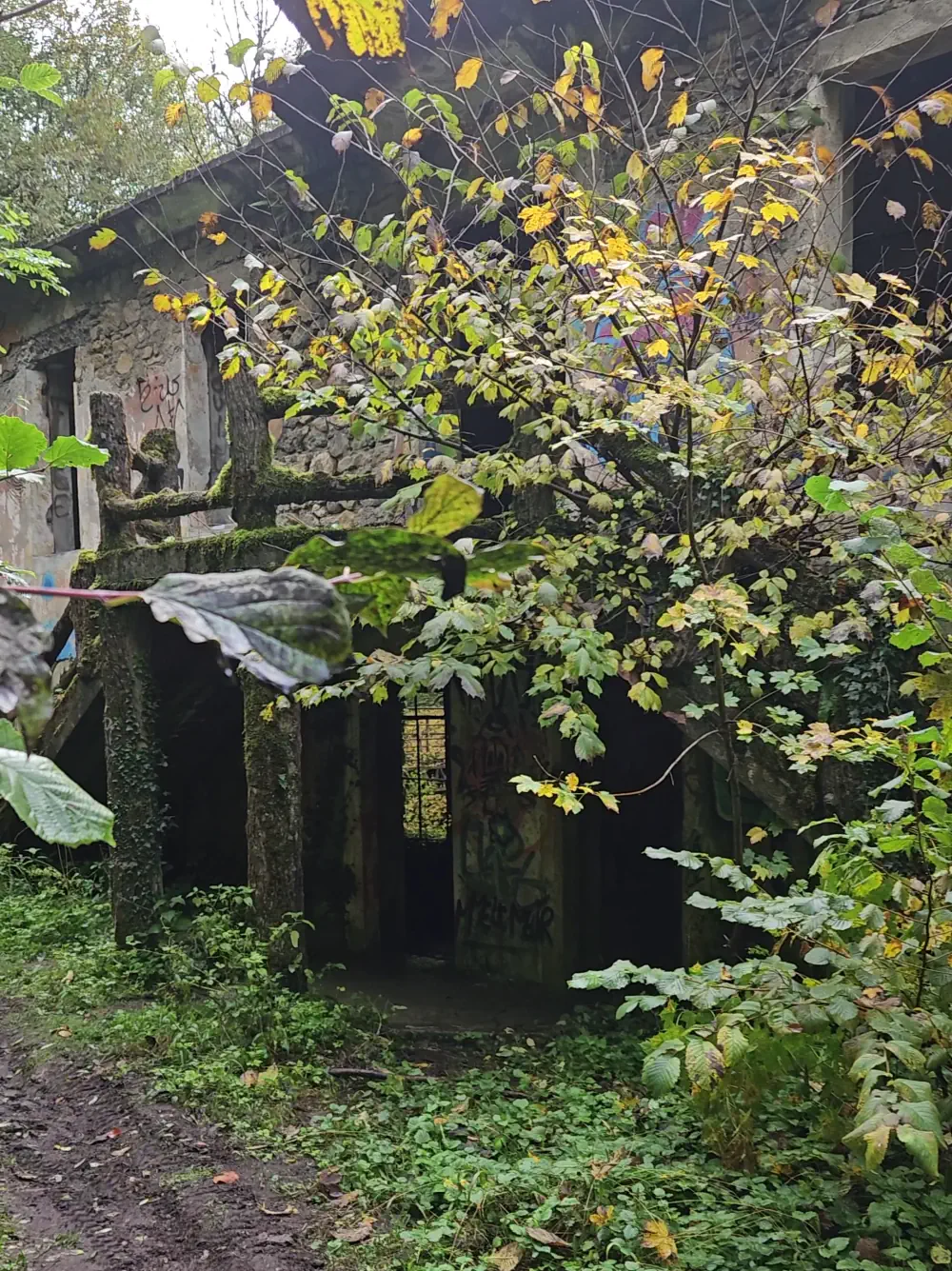
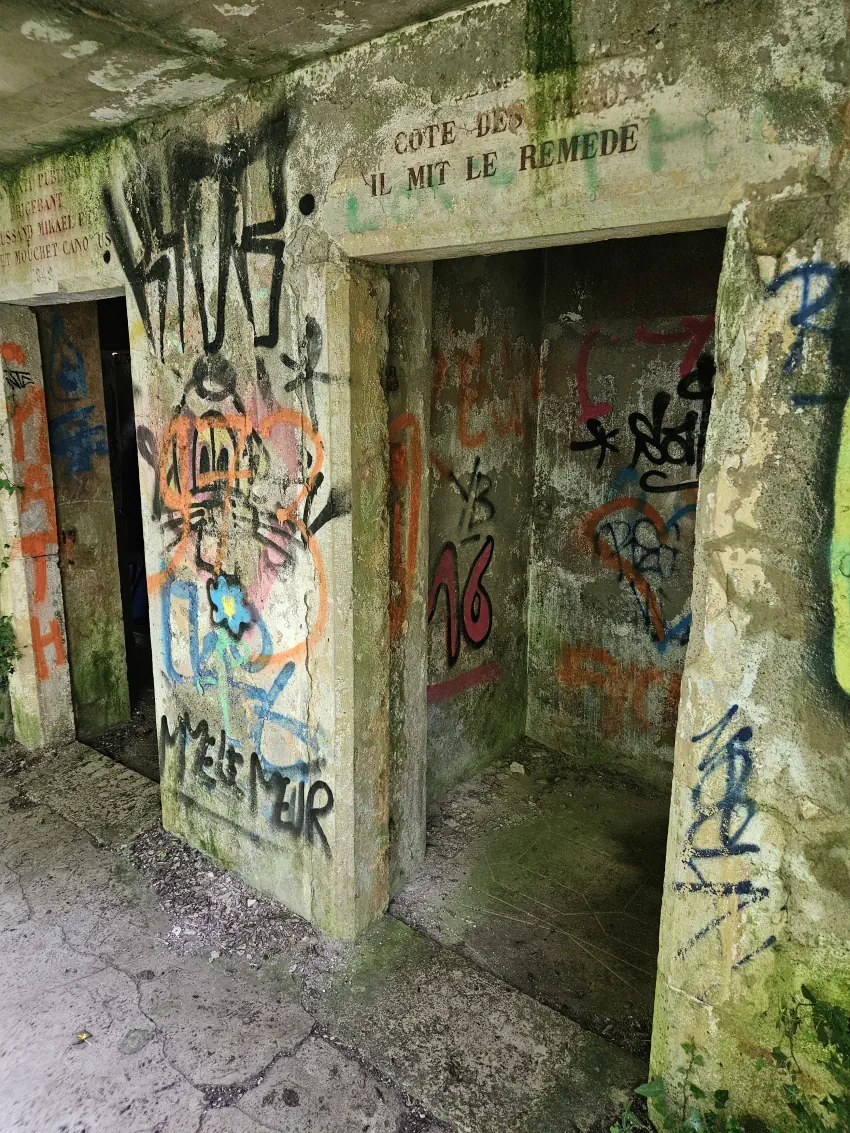
As there are no engraved marble records, it is impossible to date the discovery of the La Caille springs or identify the prominent Roman figures who visited them. The Roman baths were looted during the Barbarian invasions of Gaul in the Middle Ages.
However, there are some old inscriptions under the staircase of the building. The inscription on the left honours Mr Baussand and Mr Crozet-Mouchet, two key figures whose efforts were instrumental in making the Bains de la Caille as a renowned spa resort (in its time).
It reads ‘SANITATI PUBLICO ERIGEBRANT’ and ‘BAUSSAND MIKAEL ET CROSET-MOUCHET, CANONIQUE 1848’.
The inscription on the right, part of which is no longer legible, reads: ‘BENI SOIT DIEU QUI FIT JAILLIR LES SOURCES. À CÔTE DES MAUX, IL MIT LE REMEDE’ (Blessed be God, who made the springs gush forth. Next to the diseases, he put the remedy).
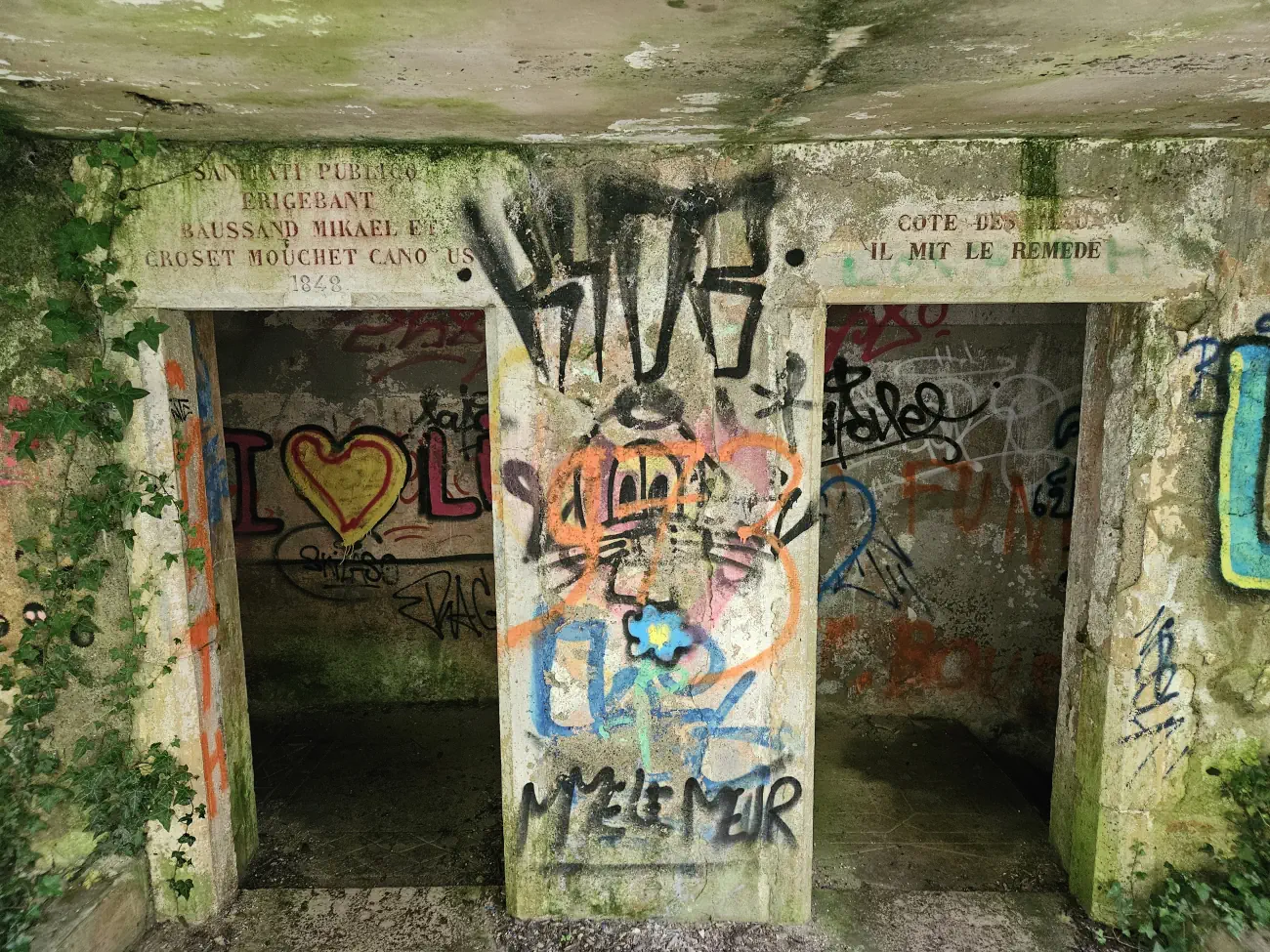
In order to be considered suitable for operation, a spa establishment must have a variety of facilities. These should include piping and water distribution systems, as well as therapy facilities.
However, as all the features that might have aroused visitors’ curiosity have been removed from the building, there isn’t much left to see. There is, though, a large disused pool on either side of the ground floor.
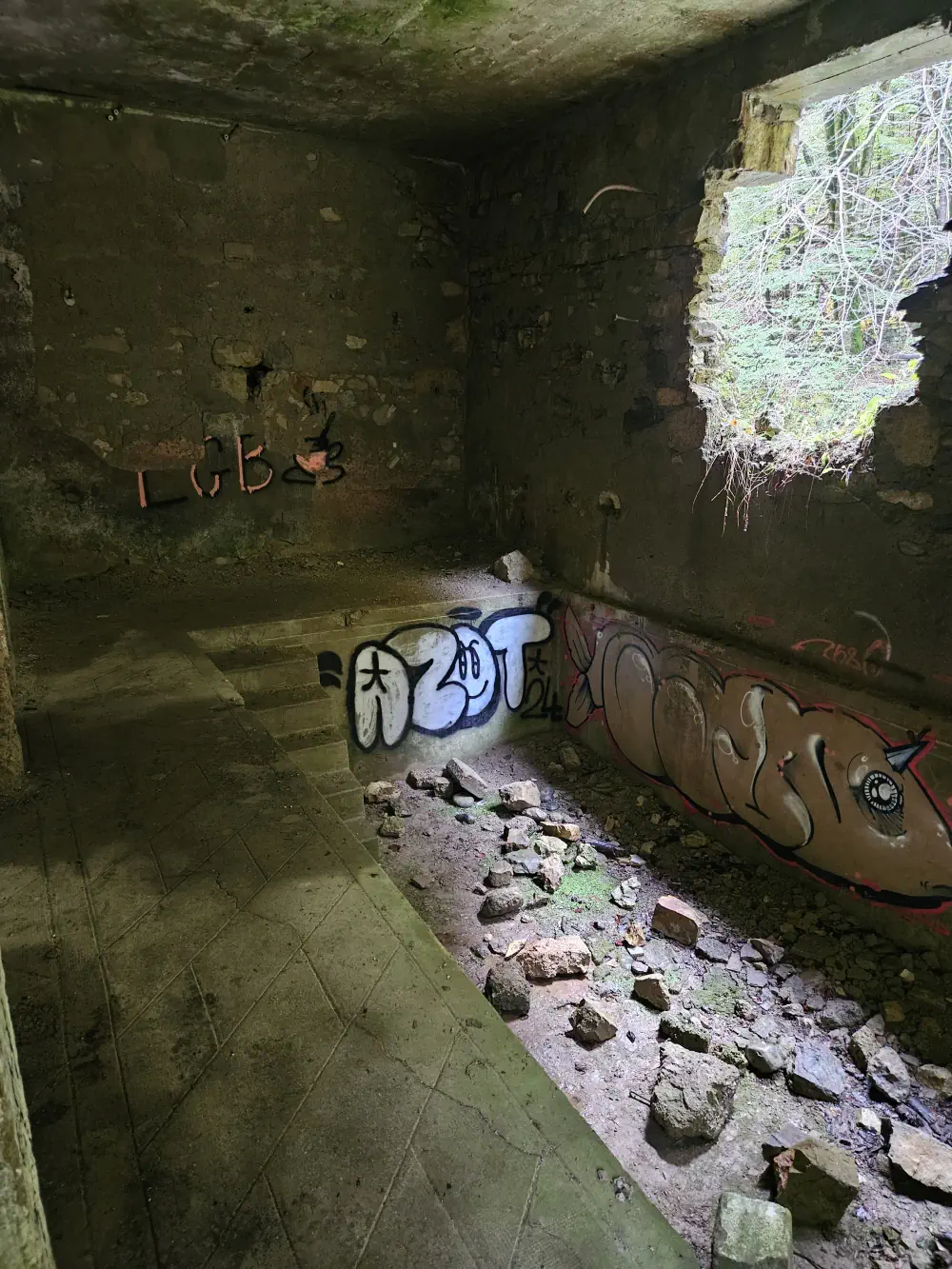
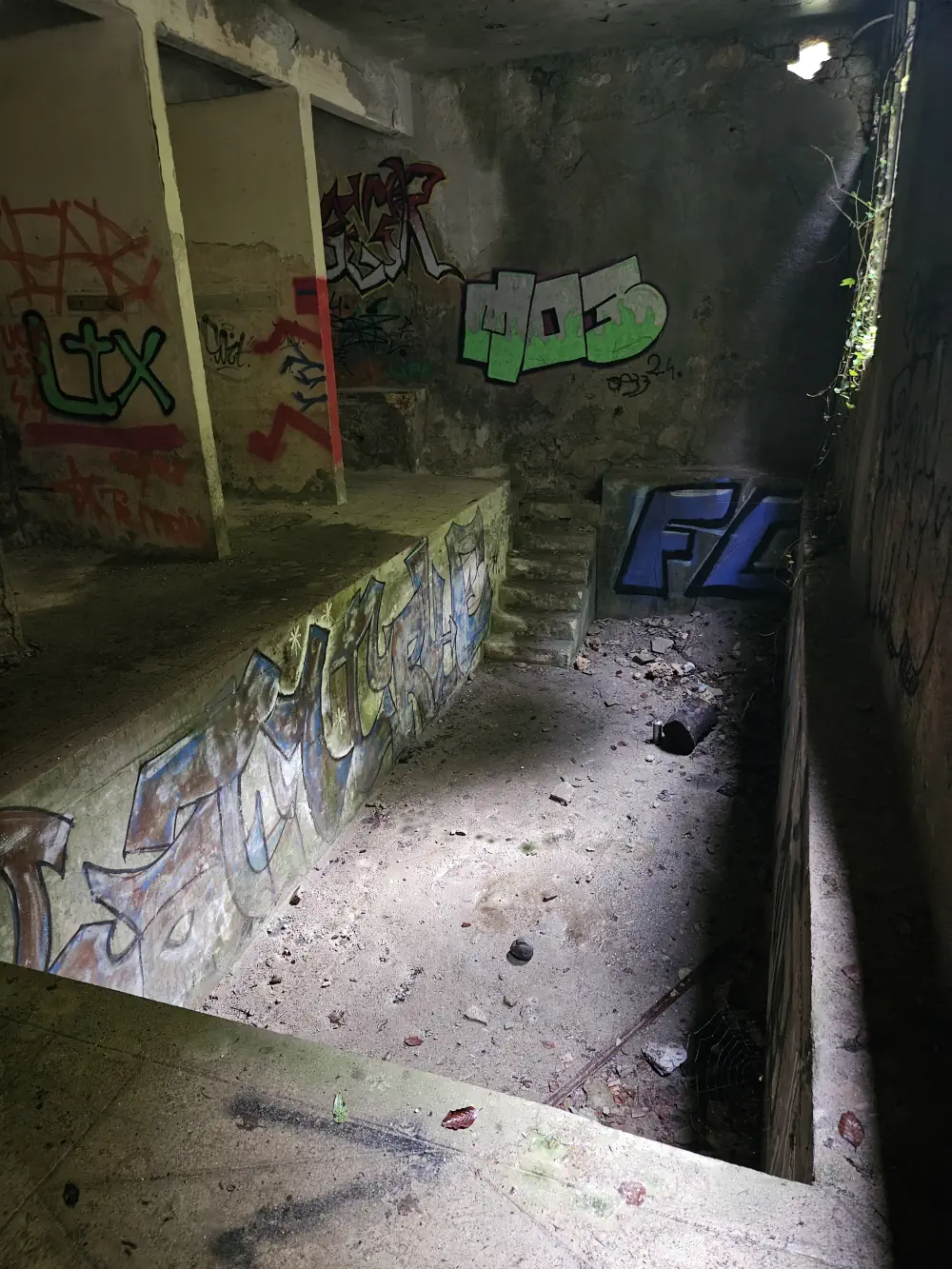
Visitors came to experience the latest innovations in spa treatments (which were spreading rapidly throughout the sector) and the new services offered by the establishment. These included fifteen bathing cubicles, steam baths and perfected Scottish showers, as well as shower and bath equipment.
The bathtubs were connected to the source via lead pipes running above the Usses torrent. We know that lead alters the quality of thermal water, causing it to lose heat more quickly than if natural materials, such as stone or terracotta, had been used instead. This meant that the water’s therapeutic properties were affected. You can find other articles about lead found in former thermal baths here (Former thermal baths of Rennes-les-Bains).
The lukewarm water, which had an emergence temperature of 30°C (too low for use in bathtubs), was heated by a boiler situated in the corridor. It was then channelled into the bathing cubicles via lead pipes. Consequently, the artificial heating and lead pipes affected the water’s therapeutic properties.
However, because the water was warmer, it was possible to enjoy the heat’s benefits even more. I suggest you read our article entitled ‘The amazing health benefits of a hot bath‘.
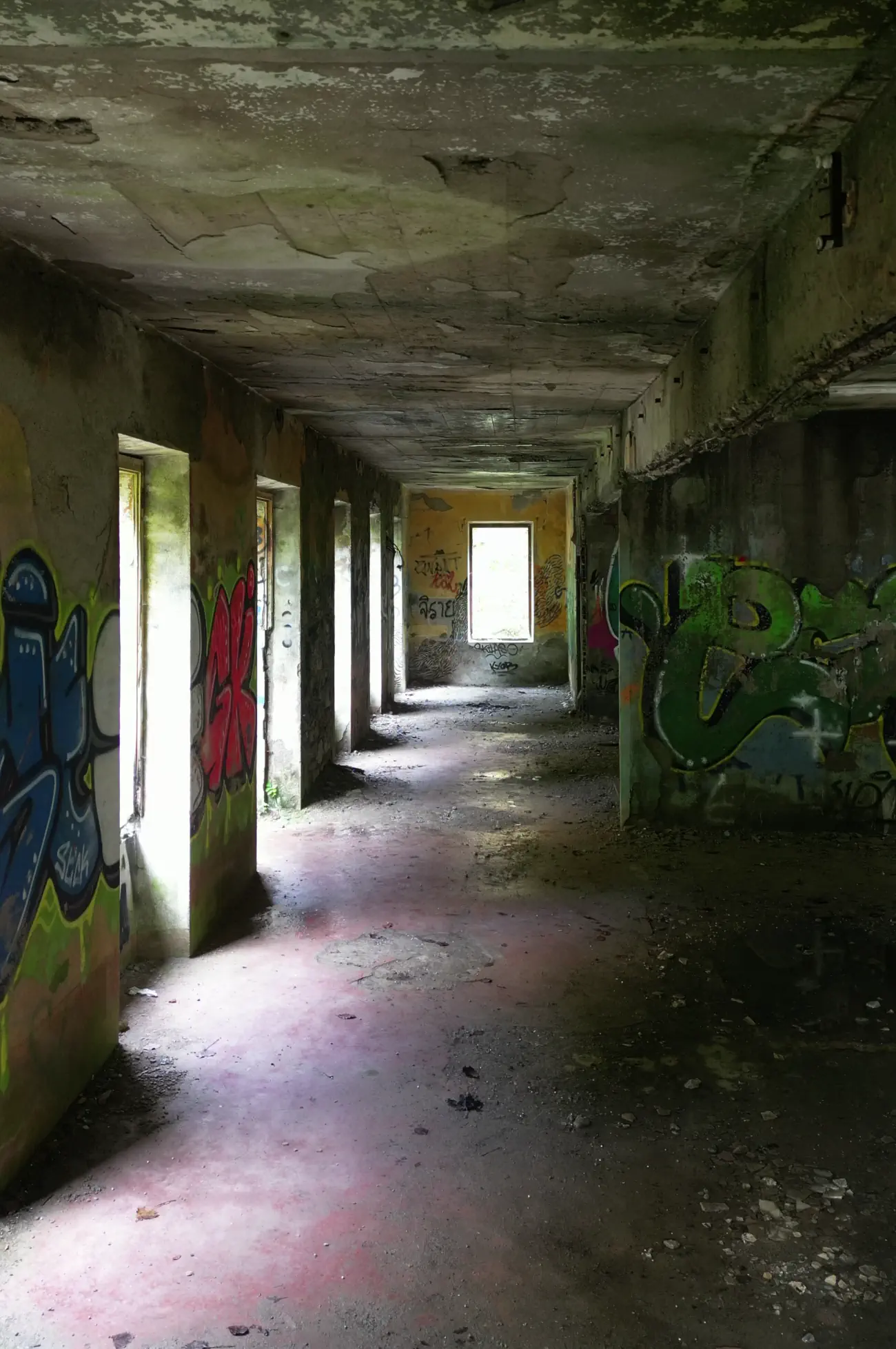
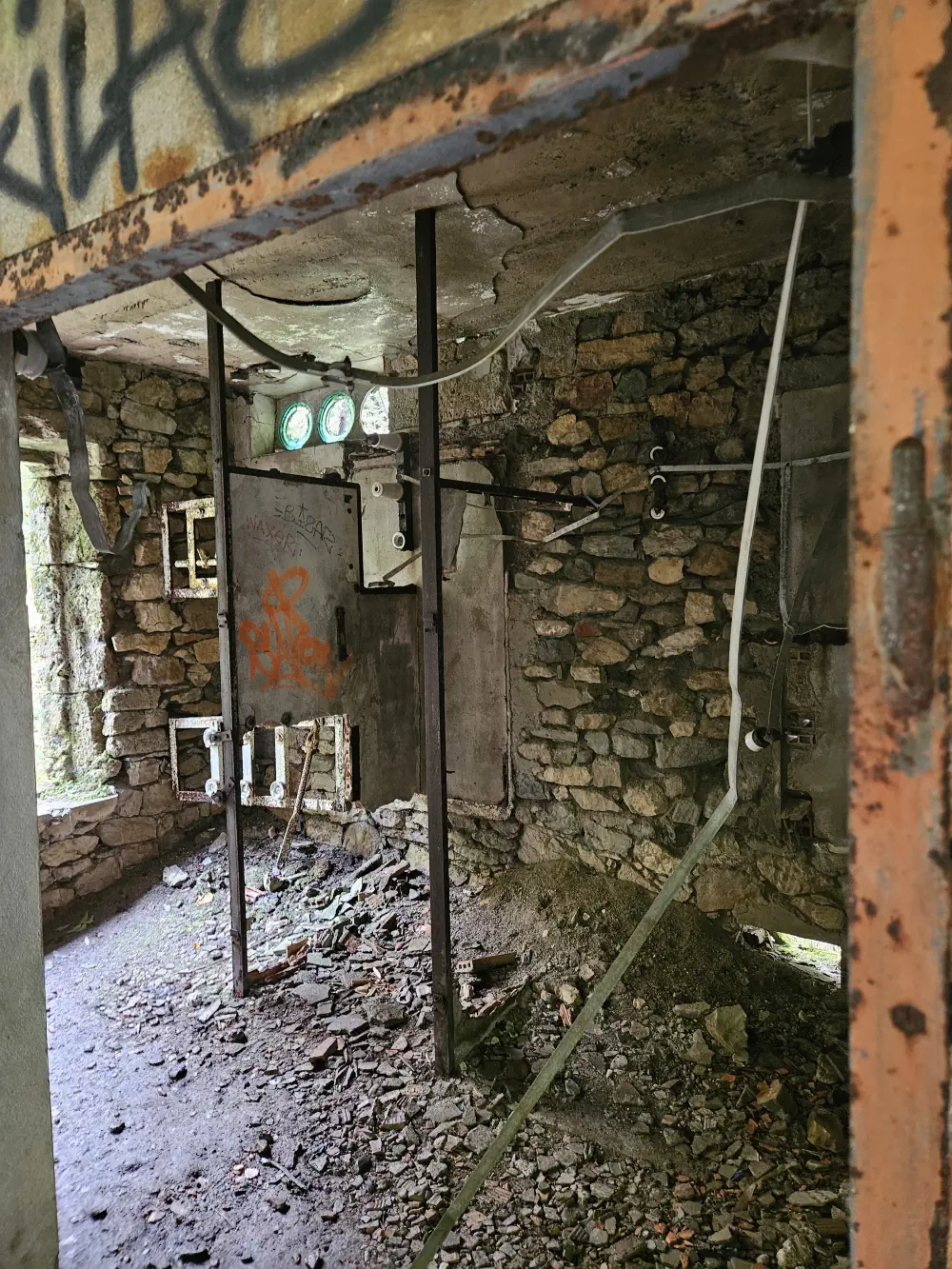
The old electrical room is upstairs. Before electricity was introduced, heating the thermal waters was an expensive and difficult process.

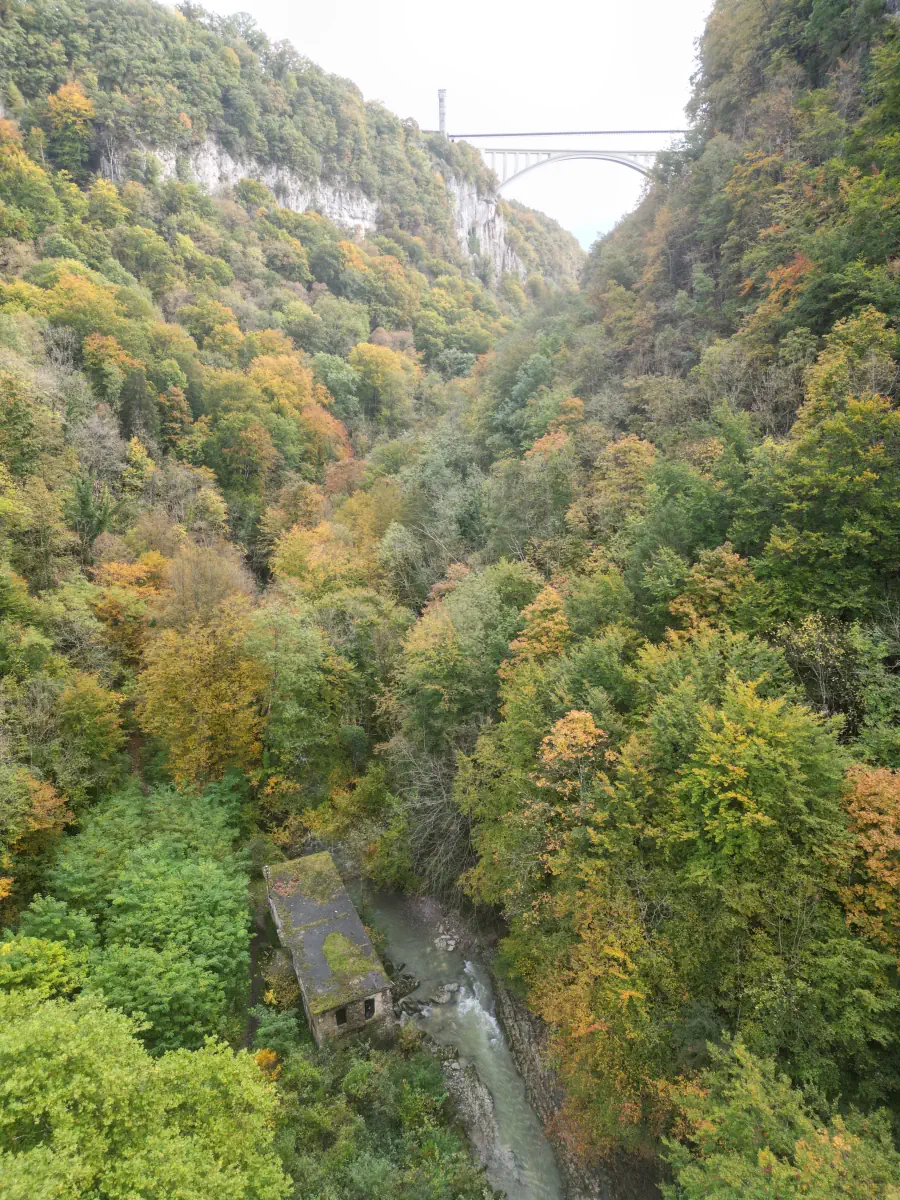
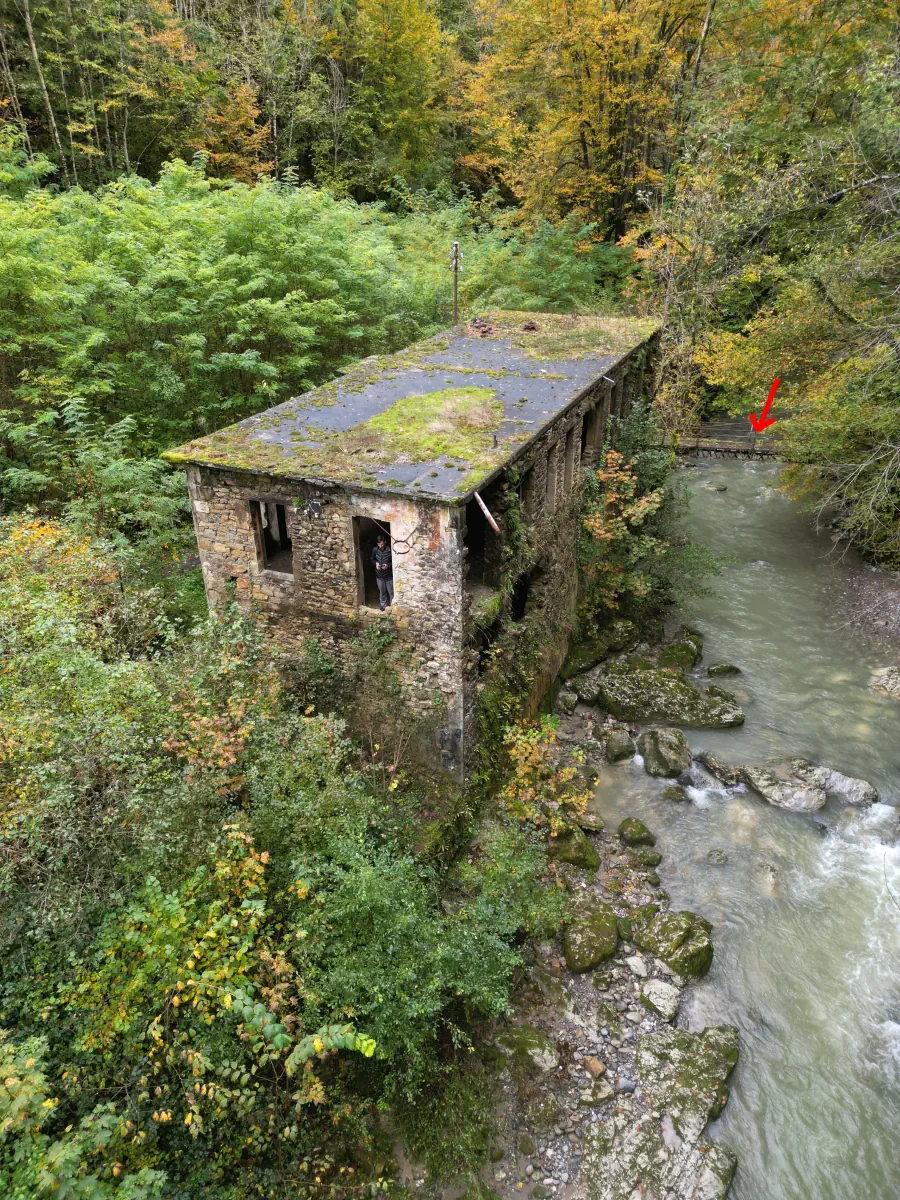
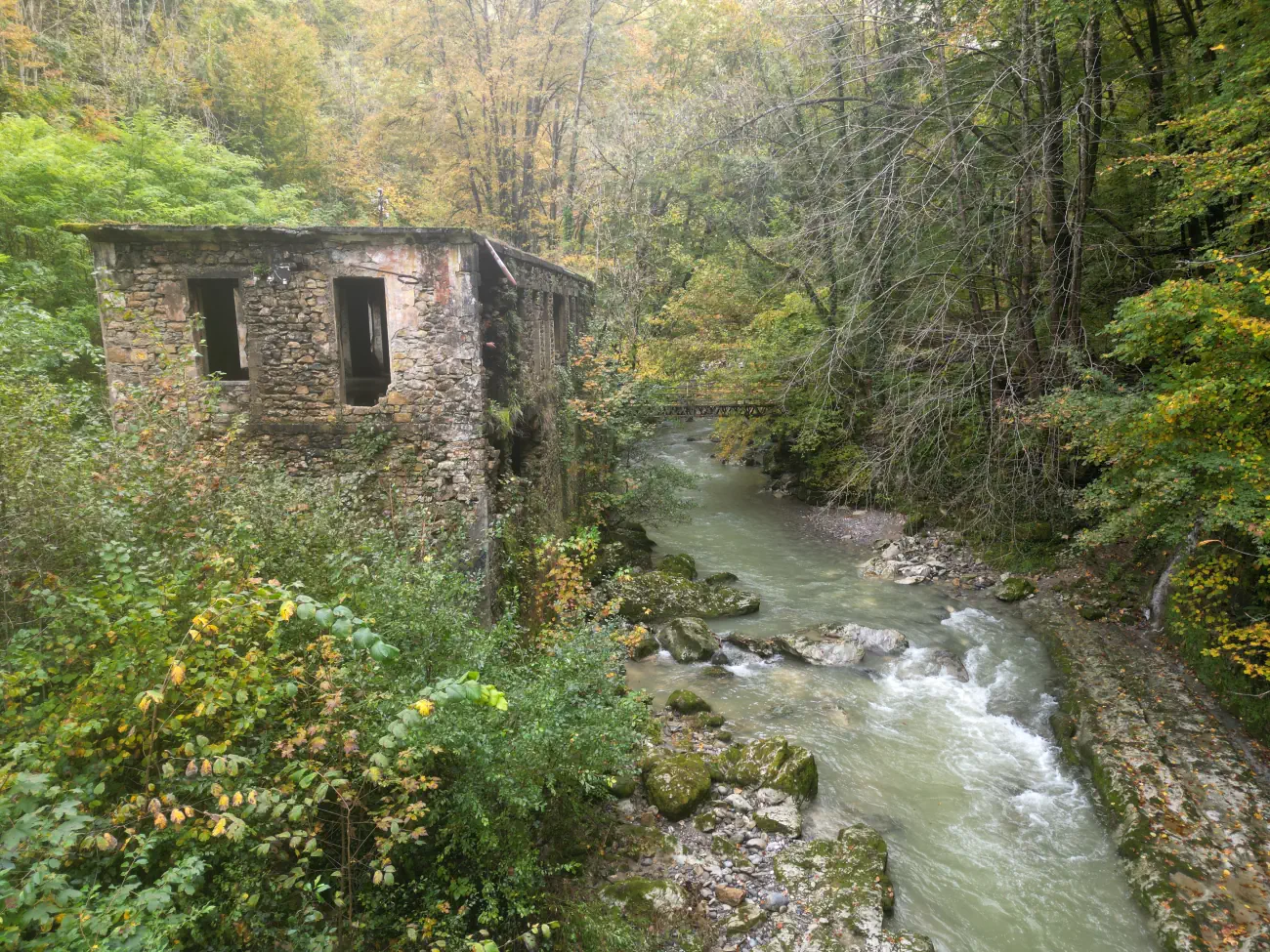
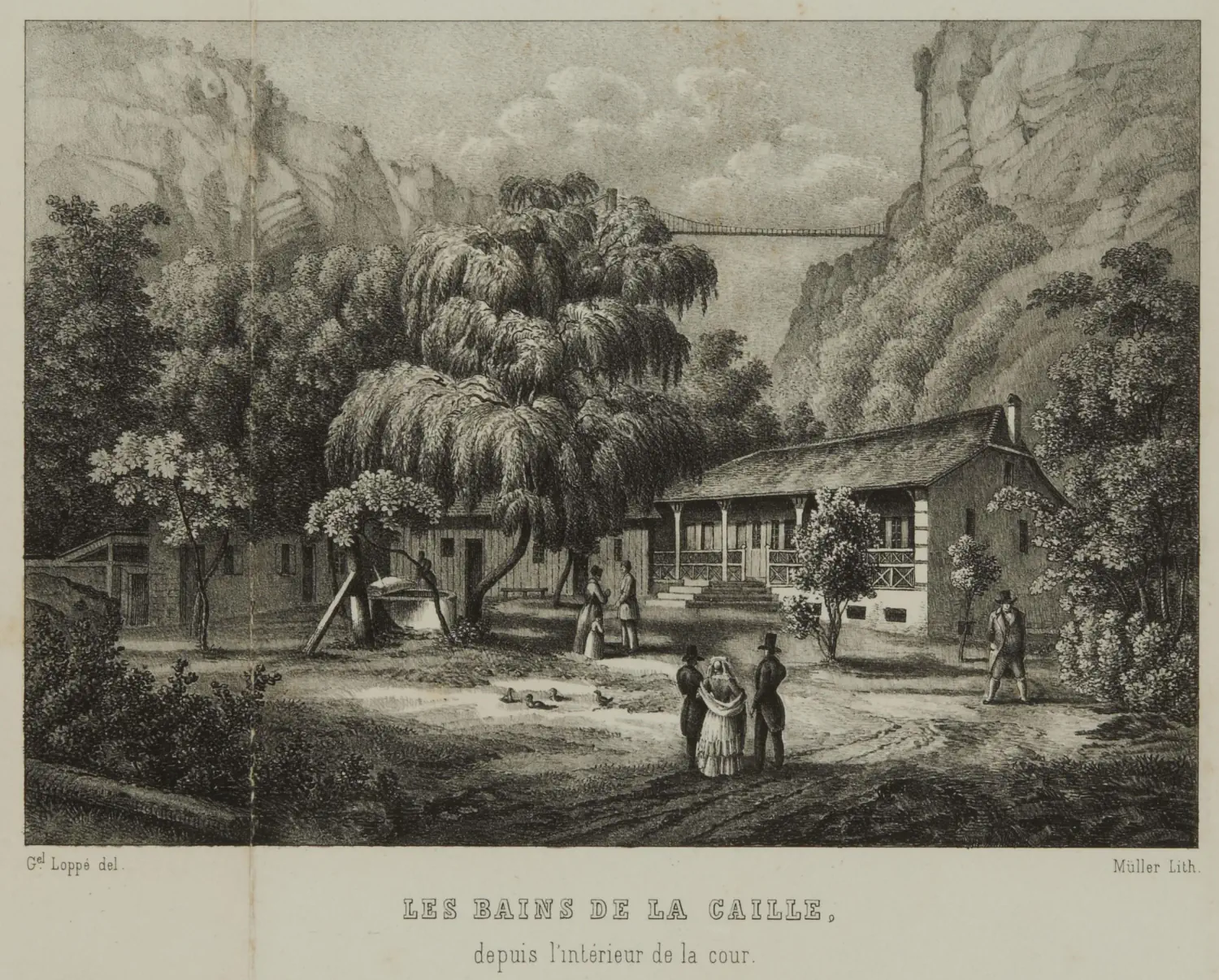
The image shows that the place is well built and surrounded by charming promenades, so travellers won’t get bored. Noblemen come here to enjoy some freedom. It is an ideal place for socialising, entertainment and pleasure.
Salons are essential for noblemen who wish to continue leading the social lives they are accustomed to.
For the sick, the attraction lay in their belief that the water had healing properties.
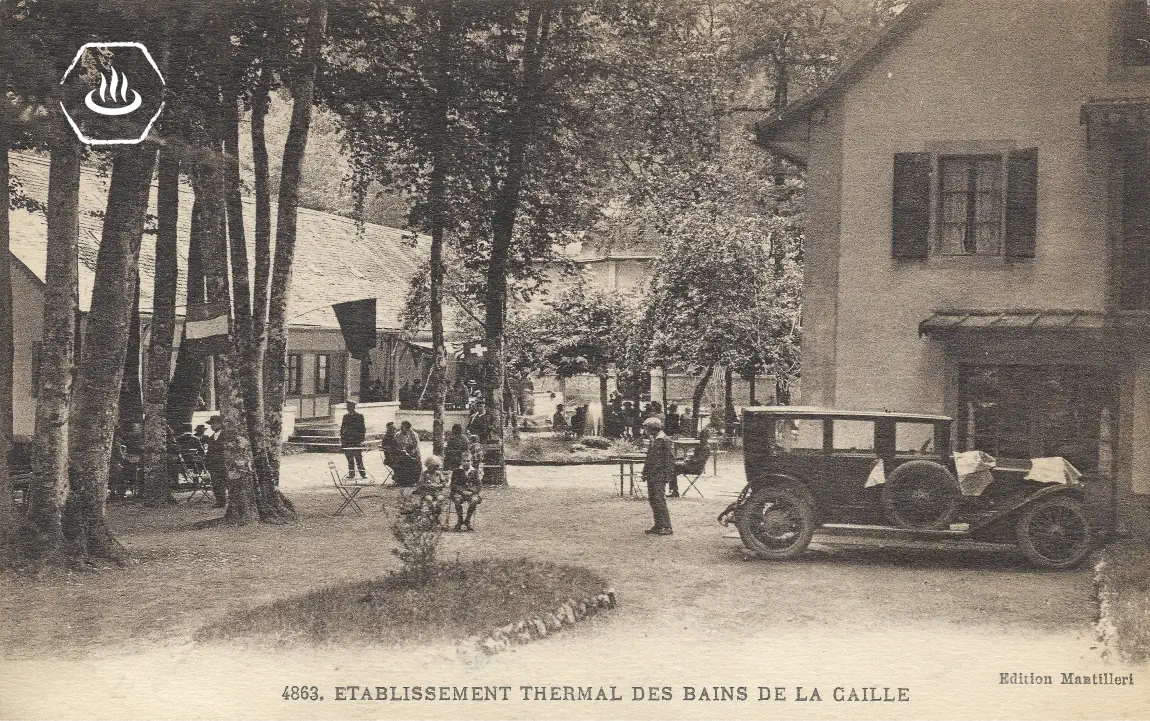
The spa season at the Bains de la Caille typically ran from late May to late September, depending on the weather. Consequently, the furnished flats were only occupied for a few months of the year.
Of the many visitors (around the 1870s), only around 120 people per season actually underwent treatment for varying lengths of time (social security did not exist at that time).
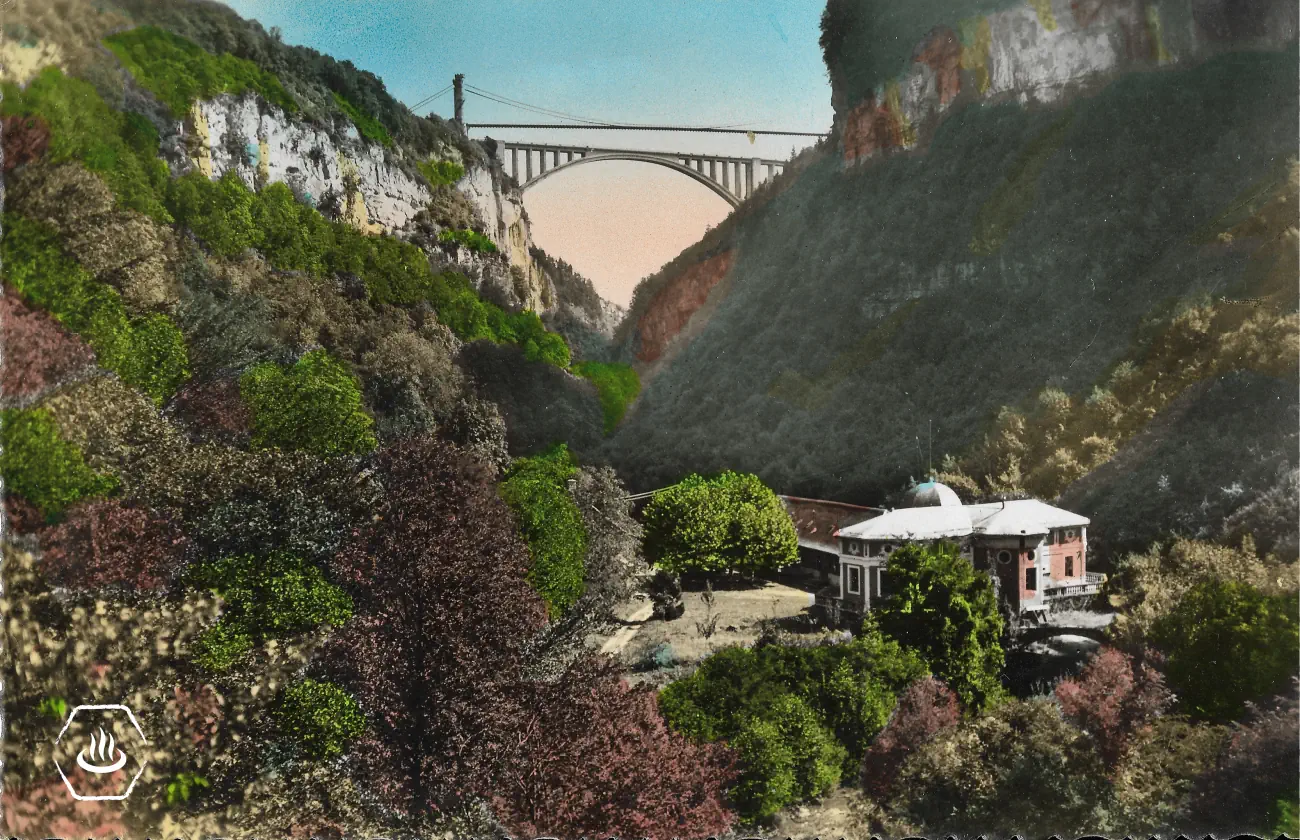
Towards the beginning of the Second Empire (1852–1870), salons gradually lost their appeal in favour of casinos, which became the focal point for artistic and fashionable activities in spa towns. It wasn’t until the 1880s that the small spa town of La Caille boasted a sumptuous Art Deco casino, as documented in 1884. Converted from an administrative building, the casino became an essential venue during the ‘spa fever’ period (1875–1890).
The shock of the First World War dashed the spa’s ambitions. Men left for the front, and hardly anyone visited the spa anymore. Business came to an abrupt halt.
The Mantilleri family took over the business in 1923. The installation of a power station soon followed, marking the beginning of a period of modernisation. Electricity transformed lighting (but also profoundly disrupts the body clock 🕰️). By around 1910, most hotels in spa towns were powered by electricity. Previously, guests had to pay for candles to light their rooms. Lounges and dining rooms were generally lit by oil lamps and gas spouts. New forms of entertainment also emerged, including concerts, balls and parties, as well as new facilities such as tennis courts and swimming pools.
In 1960, activity at the spa resort ceased.
The sulphur springs
The two springs on La Caille’s hillside are no longer in use. With a total flow rate of around 100 litres per minute, they were never particularly suitable for spa operations. Today, their flow rate has probably decreased and the water temperature is only 21°C.
📜 In general, thermal waters are subject to a rule whereby their temperature, mineralisation and flow rate remain constant unless they are affected by earthquakes, volcanic eruptions or poorly executed catchments.
The sulphurous springs of La Caille are in a geographical location that puts them at a disadvantage, meaning nobody visits them anymore.
After crossing the slightly rickety metal footbridge, you will reach one of two springs where water flows into the forest.
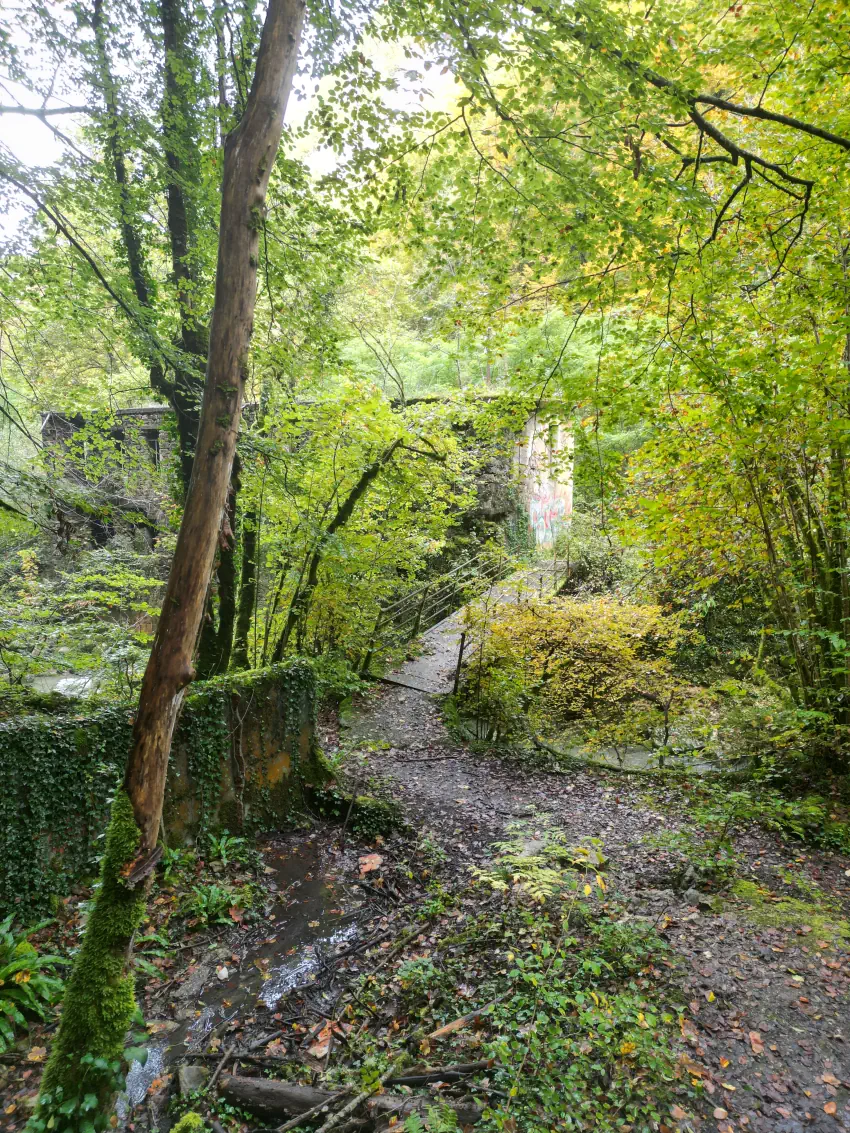
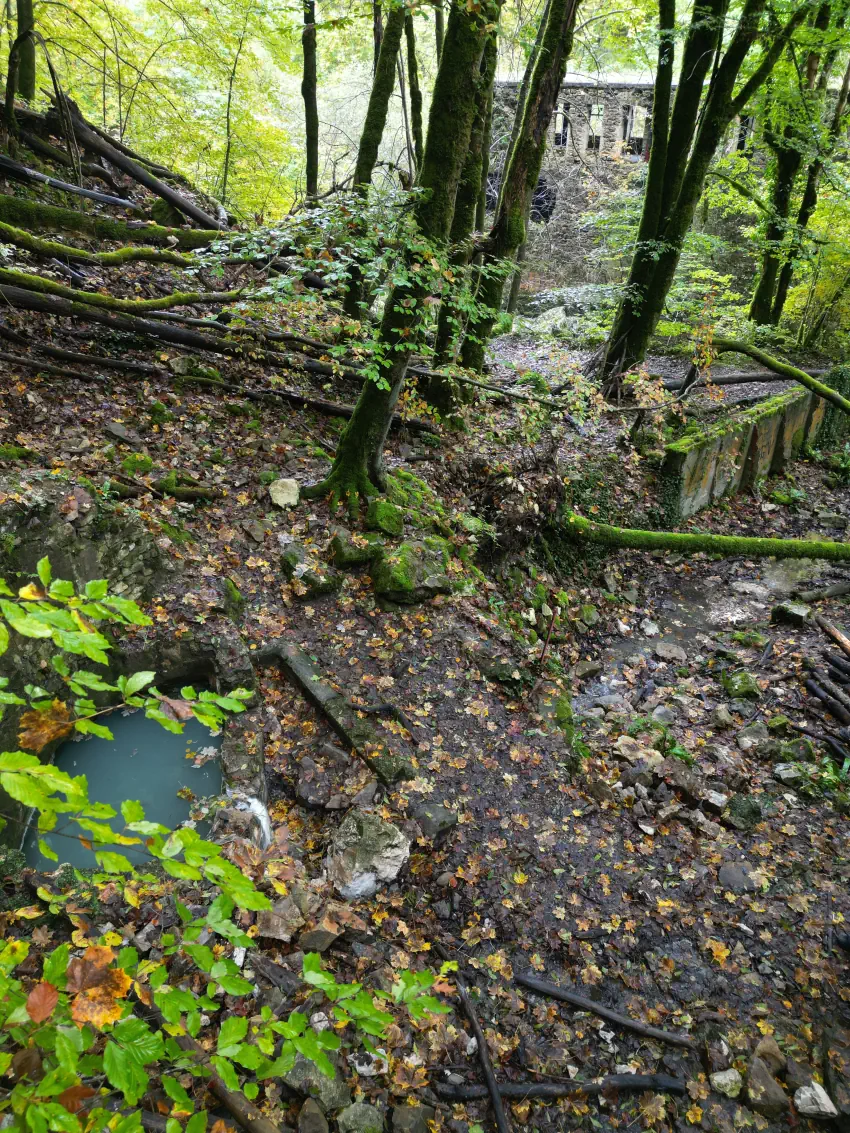
Although this pool is small, it is relatively deep, at around one metre. It gives off a strong smell of rotten eggs. This is because it is highly concentrated in sulphur, which is why a ‘castle‘ was built to house the sulphur spring and form the ‘pneumatic establishment‘ — a term used to describe anything to do with air and gas.
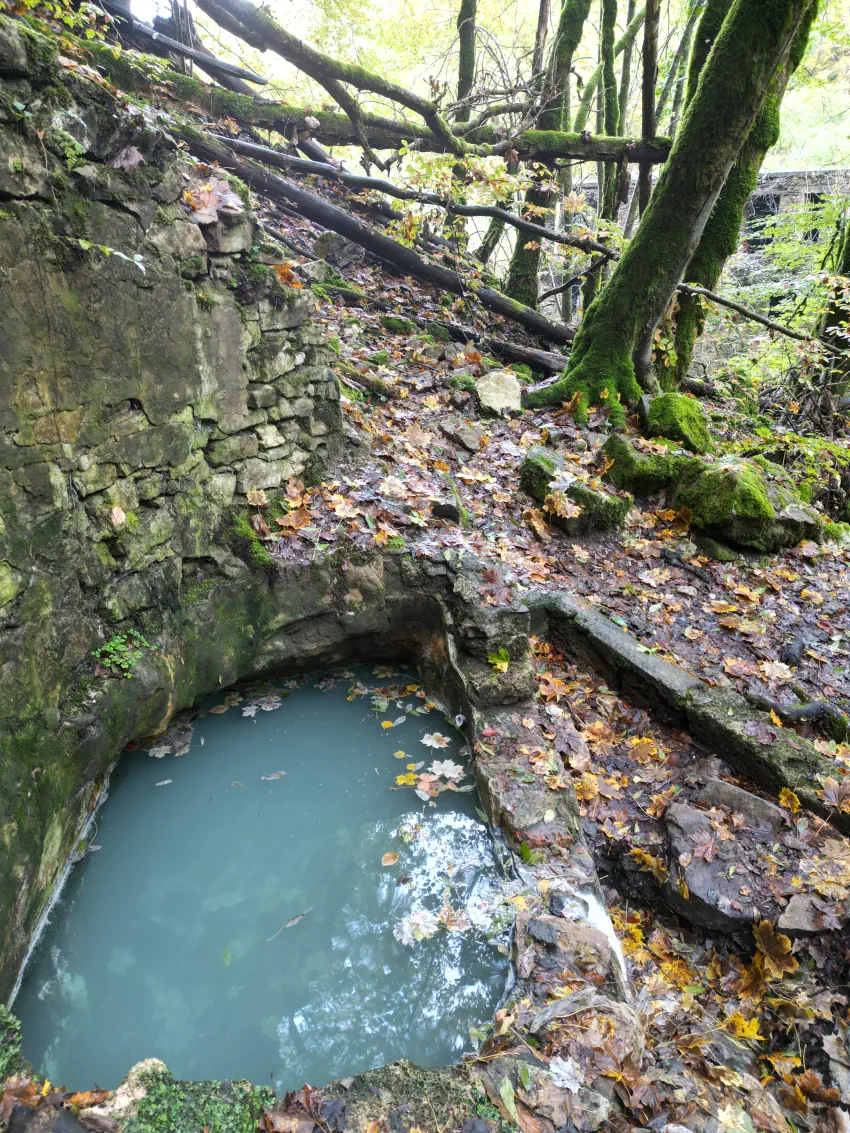
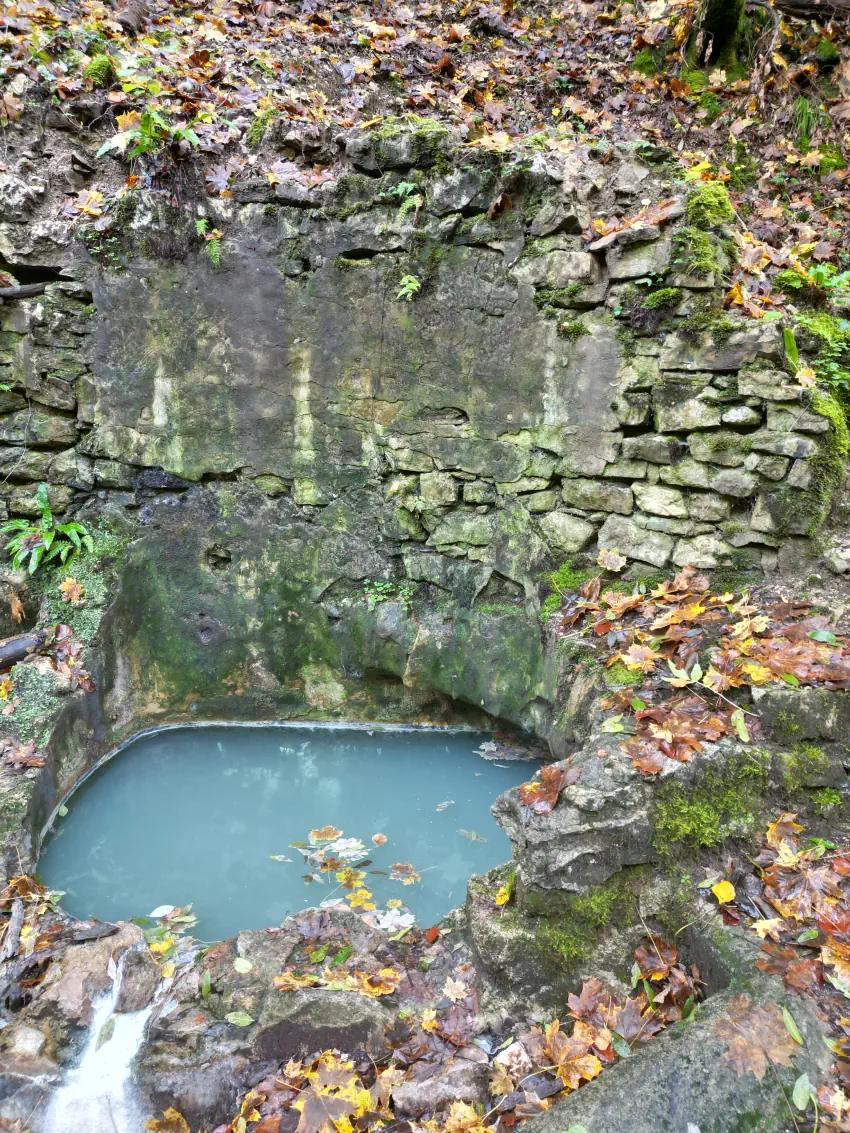
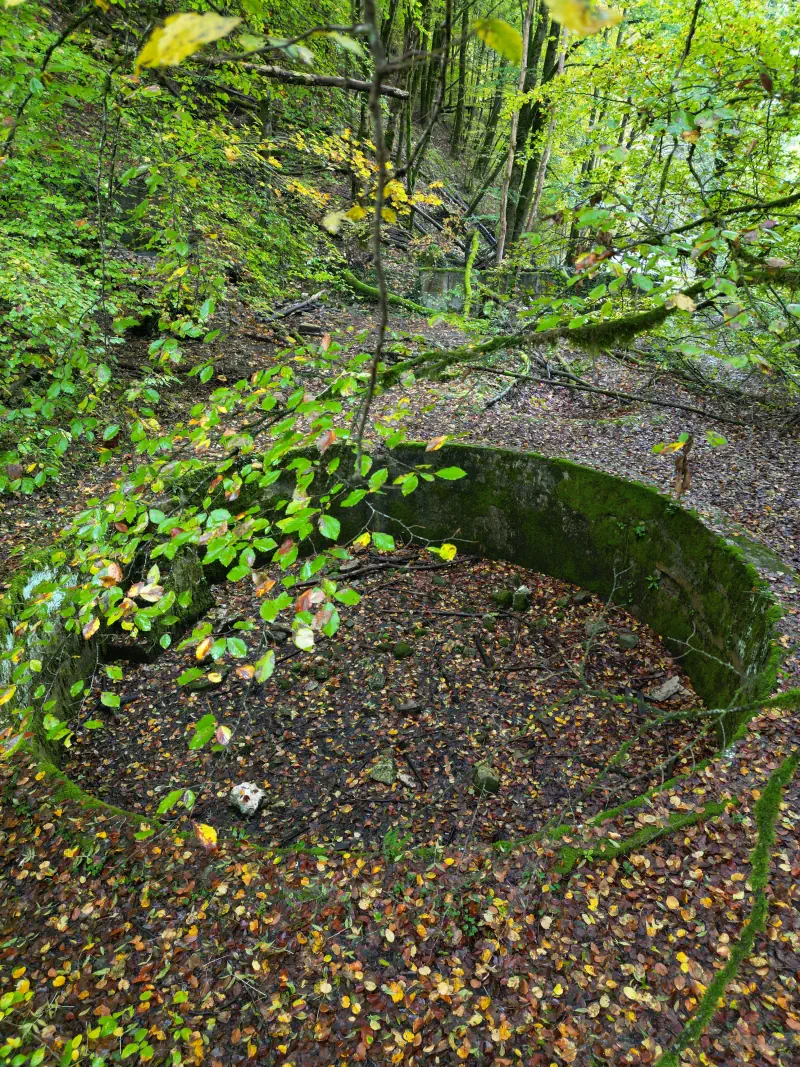
Now that the castle has been demolished, light can reach the spring again. This allows photosynthetic microorganisms, which feed on light, to flourish. The entire ecosystem, consisting of various microbial communities, plays an active role in maintaining water quality (see our article). Consequently, the spring’s therapeutic properties were different when it was enclosed on all sides.
You will also find the old outdoor thermal pool nearby.

A few dozen metres from the spring and opposite the baths stands a 15,000-litre tank which was probably used to store water for everyday use. It would have been filled with water at night.
Although this spring comes from the same hot water deposit as the first, it has a lower degree of sulphuration. The water is 21°C, having probably lost a few degrees due to the large volume of water. Storing thermal waters could also affect their therapeutic value.
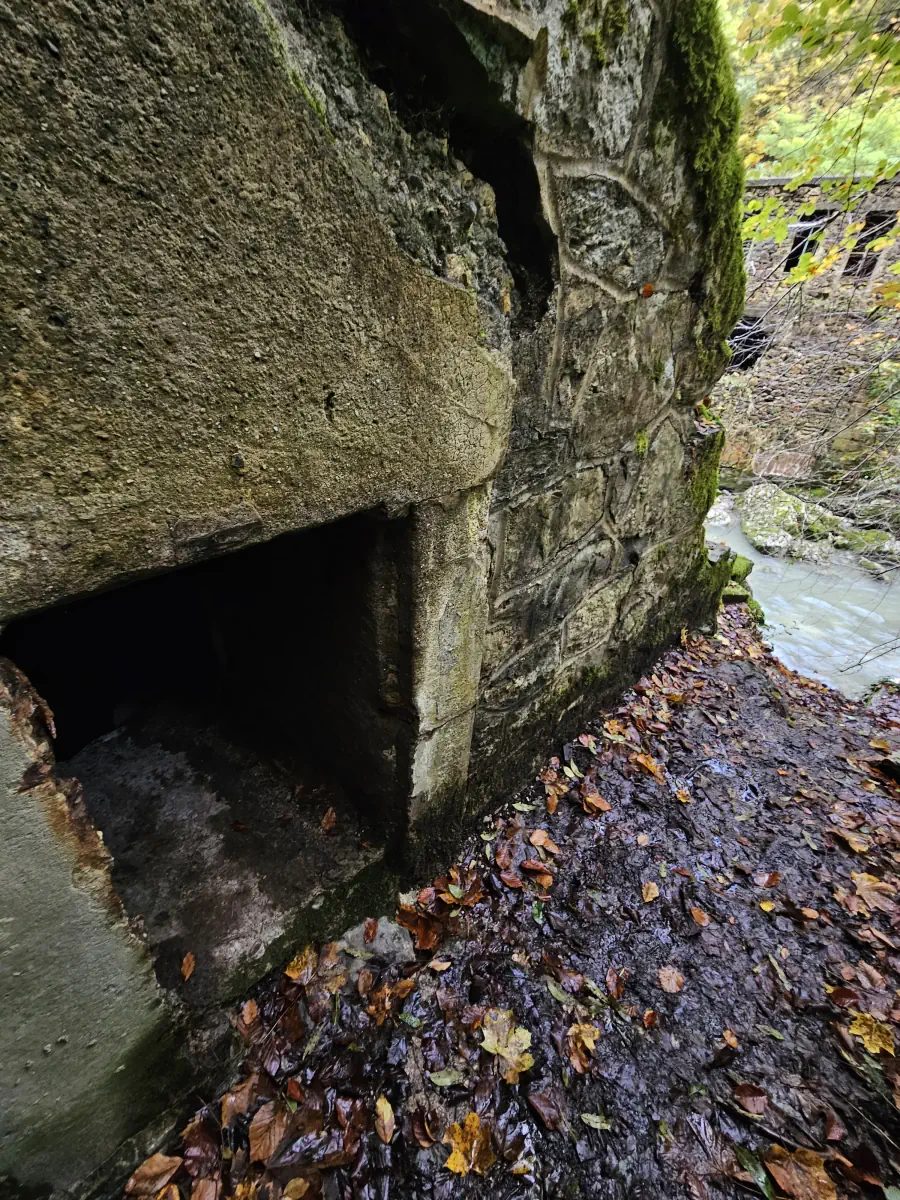
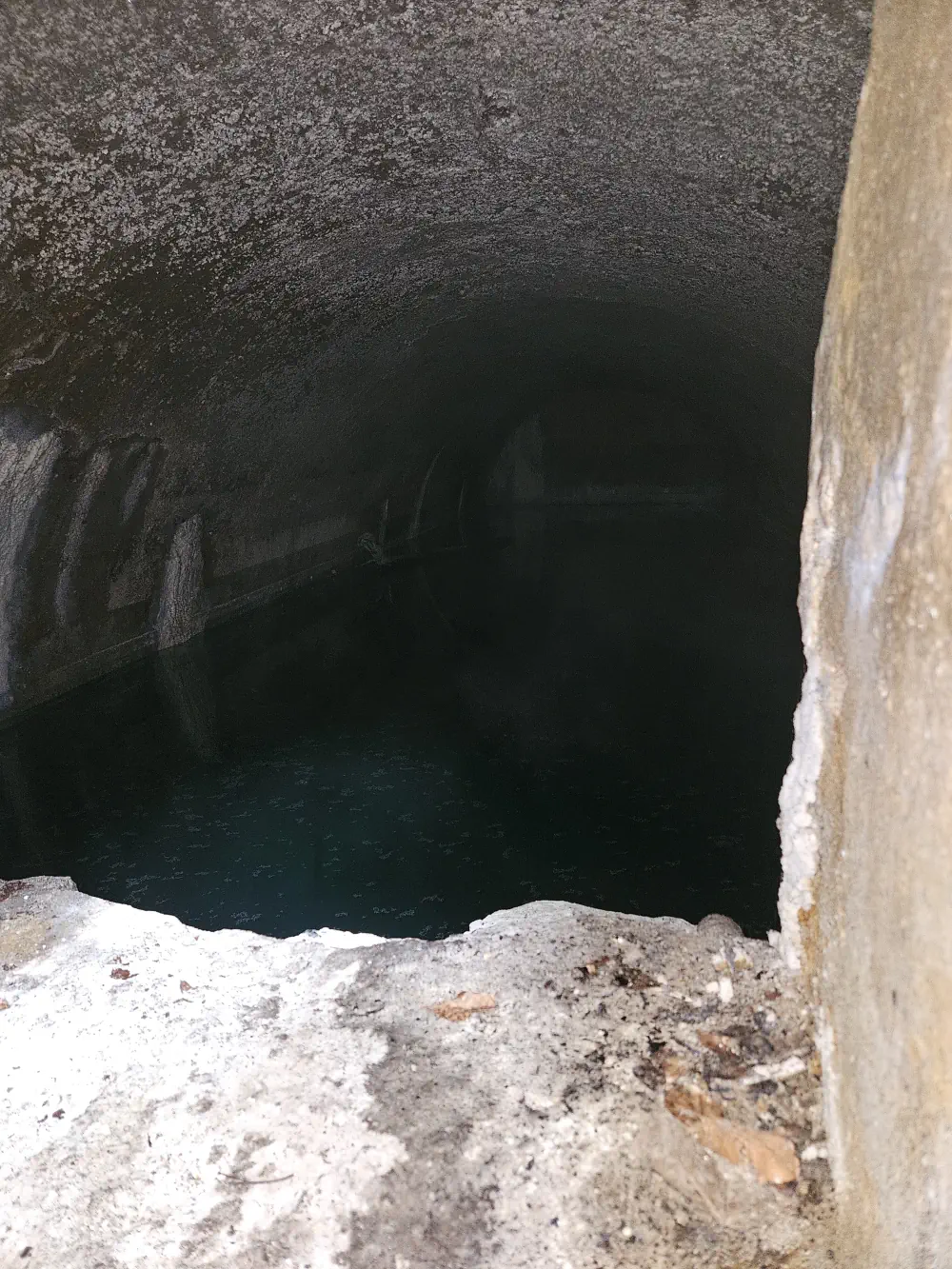
Its function was to supply the baths on the opposite bank with lead pipes. The structure continues just below.
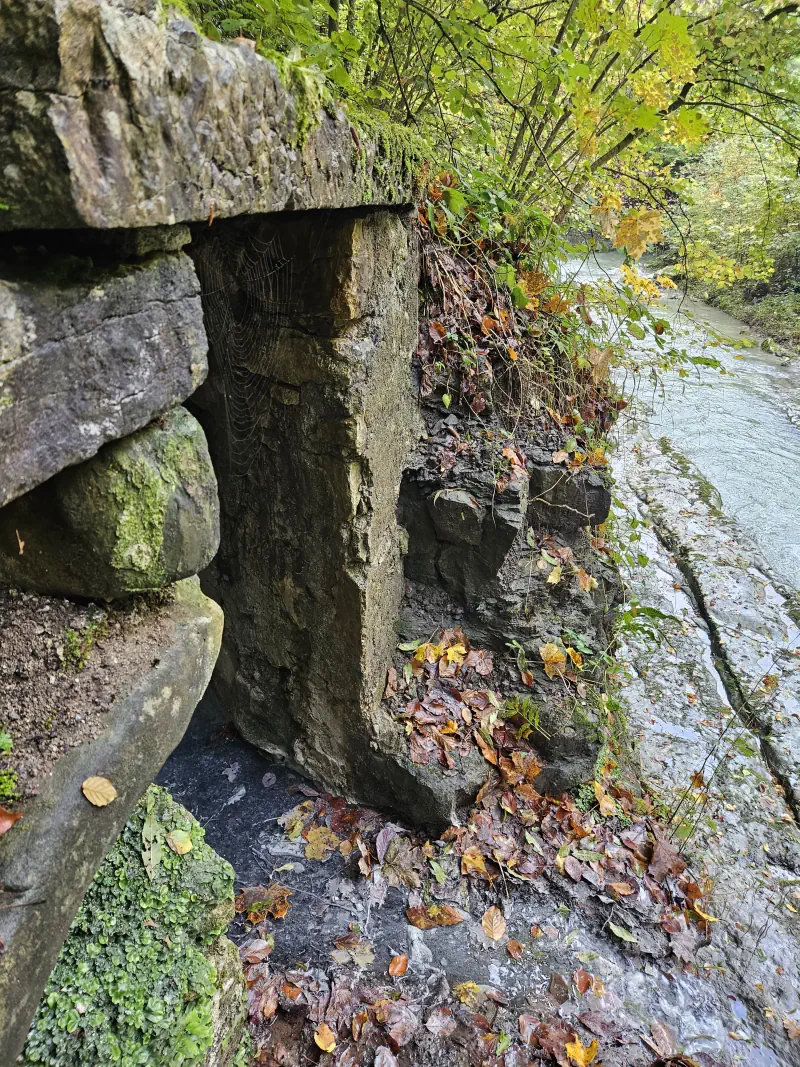
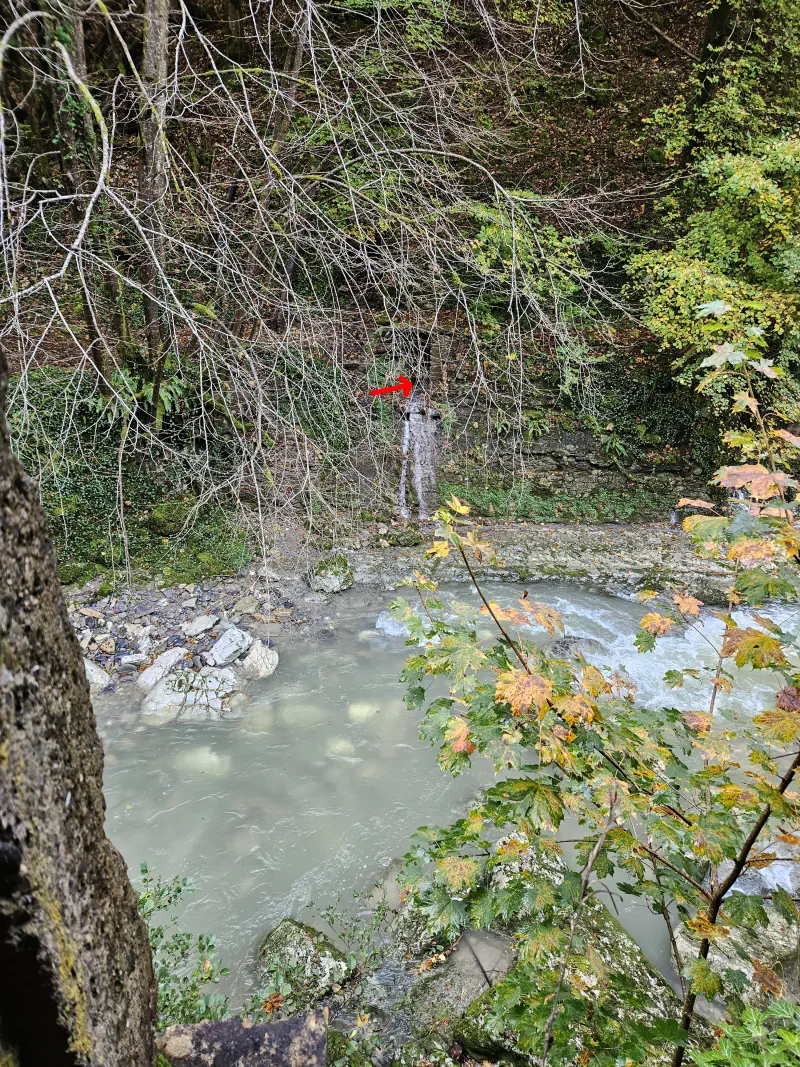
Overflow from the tank escapes through this wall and ends up in the nearby Usses Torrent.
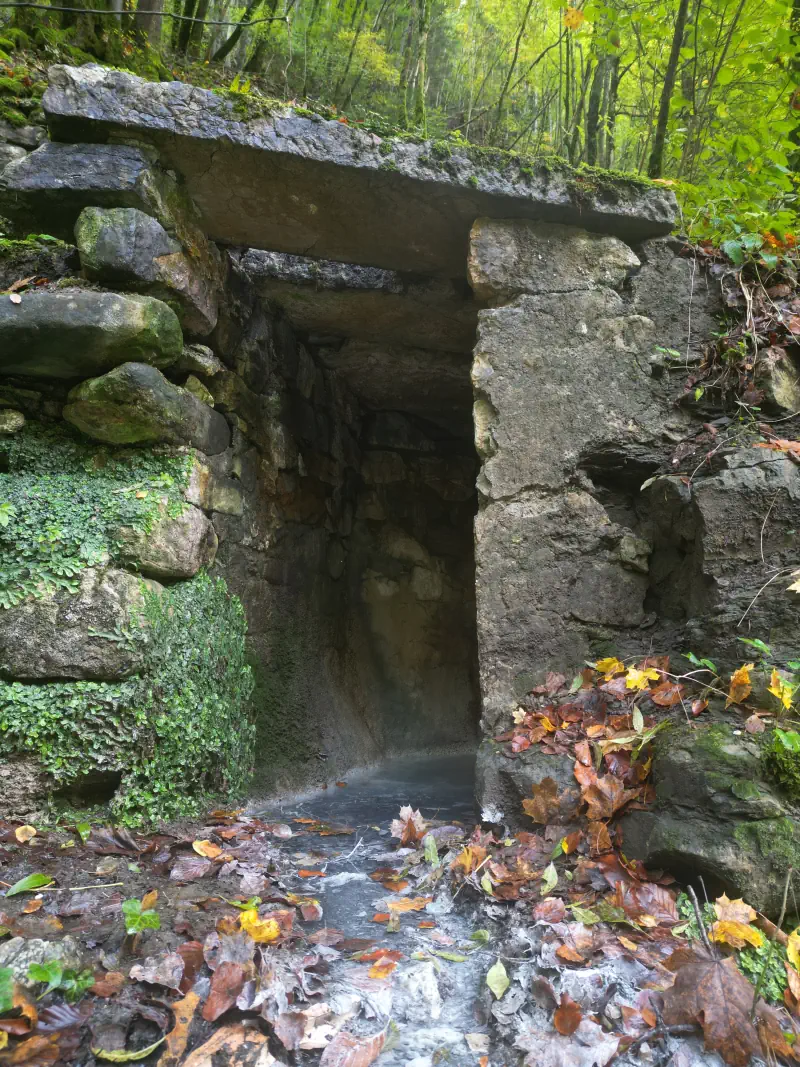
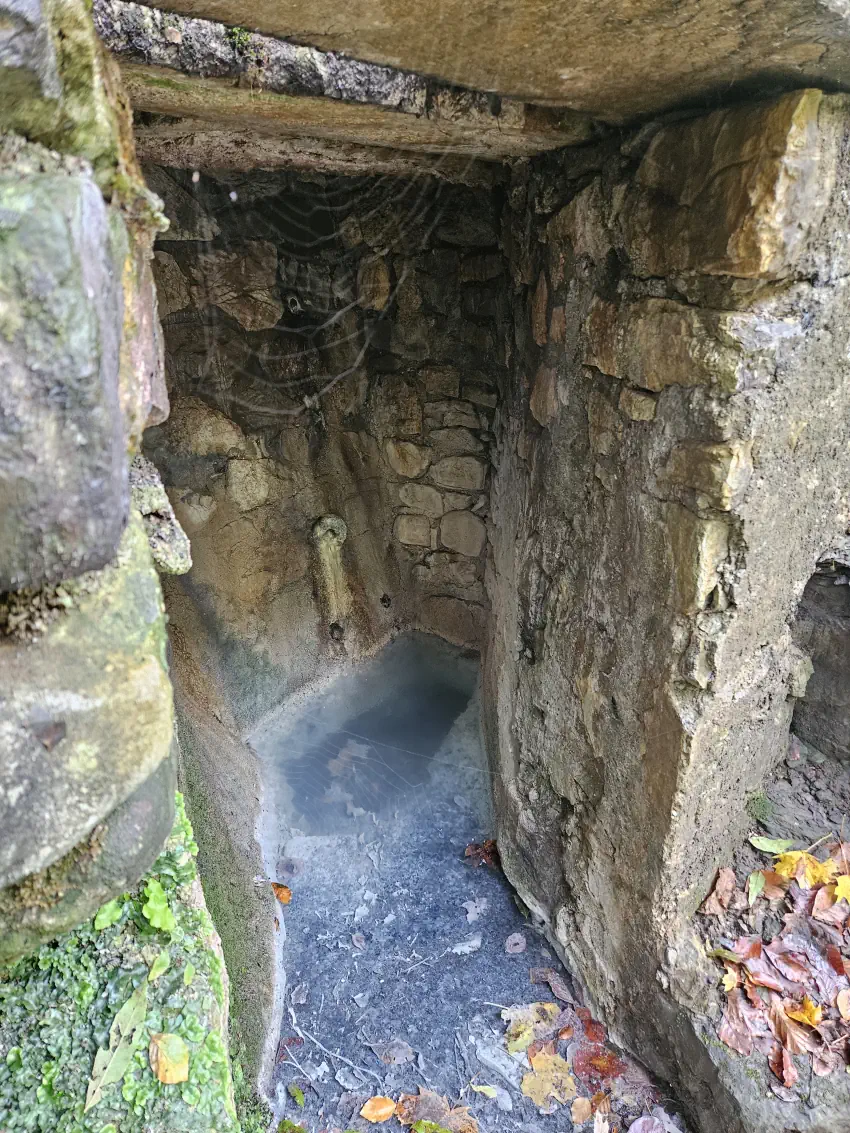
Both of these springs contain large quantities of glairine. This whitish substance is clearly visible.
Glairine, which is produced by bacteria, has many beneficial properties, including antibacterial, anti-inflammatory, anti-allergic and healing properties. However, these bacteria represent only a small proportion of the microorganisms present in the spring (bacteria, archaea, viruses, etc.).
The nature of water and its therapeutic properties
These waters have a mineral composition comparable to that of some of the springs at Bagnères-de-Luchon, which are considered the most sulphurous in the Pyrenees.
They have the following in common:
– very low total mineralisation;
– an alkaline pH of around 9;
– a marked sodium sulphide chemical character;
Magnesium is present in trace amounts.
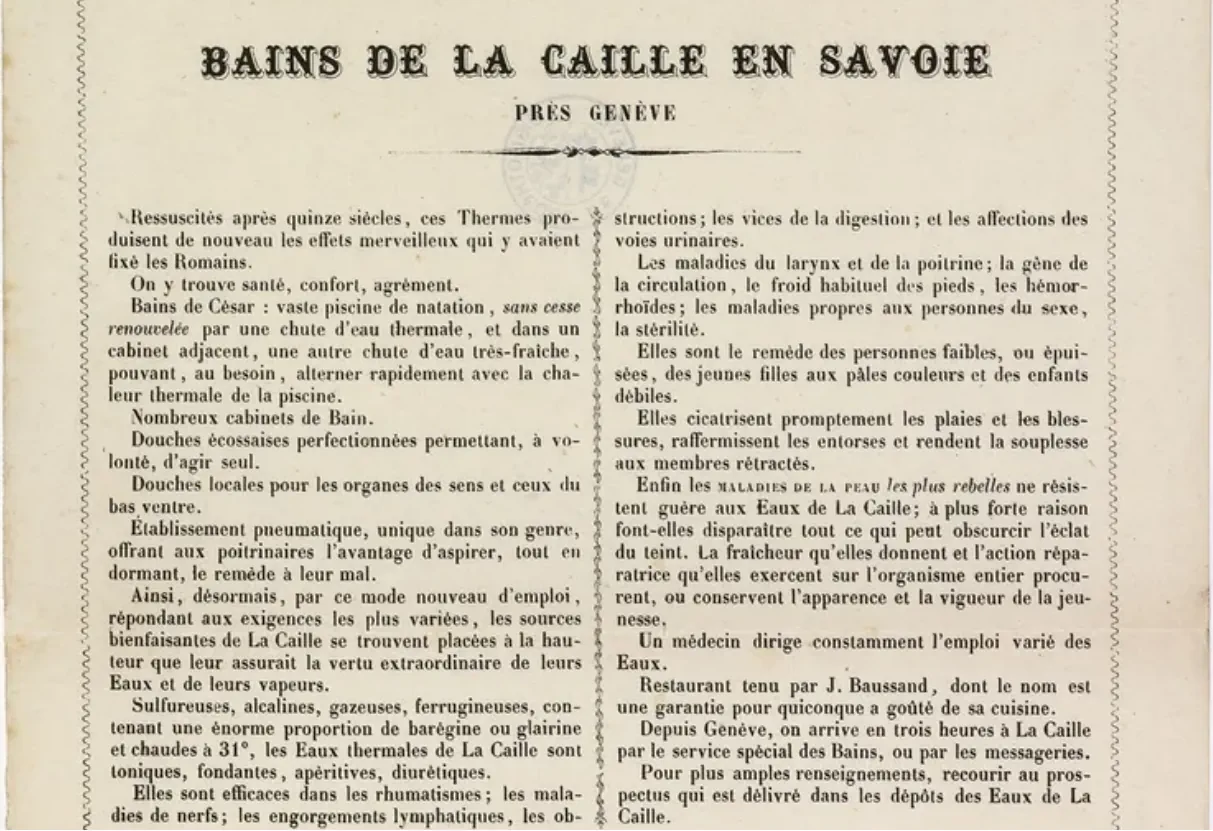
It is said that these waters have healing properties that can help with various skin conditions, chronic rheumatism, laryngeal and chest diseases, scrofula, and glandular congestion, to name a few.


